When visiting Mexico City, the names Diego Rivera and Frida Kahlo seem to appear everywhere you go. The married couple is a historic powerhouse in the world of Mexican artistry. Oddly enough, during their lifetime, Diego Rivera was the most well-known and Frida only lived in his shadow. And yet these days, Frida has internationally far eclipsed her ex-husband’s work. But the powerful legacy of Diego Rivera lives on here in Mexico City. Unlike Frida, whose artworks are spread worldwide, Diego Rivera’s work is attached to the city. Like the beating heart which pulses underfoot.
Diego Rivera was a Mexican painter, muralist, and pioneer in the art of social realism. He is best known for his monumental frescoes depicting Mexican history from the conquest to the revolution. His work has been exhibited worldwide, housed in the most prestigious museums. But the best examples of Diego Rivera’s work can be found here in Mexico City. In public spaces as well as time-honoured museums. This guided tour takes you across the city, diving into unknown corners and popular tourist sites. So come with me on a walking tour in the footsteps of Diego Rivera.
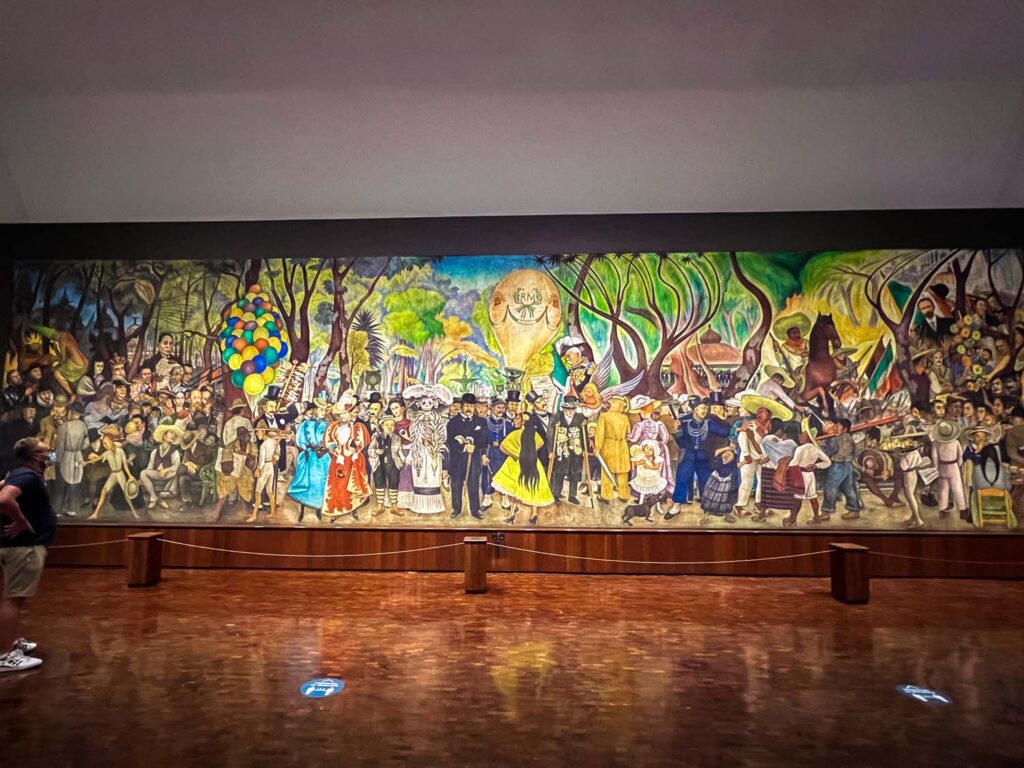
- About Diego Rivera
- Start of the Tour: El Cardenal
- Museo Mural Diego Rivera
- Dream of a Sunday Afternoon in the Alameda Central
- Palacio de Bellas Artes
- Mexican Secretaria of Public Education Headquarters
- Former College of San Ildefonso
- Mercado Presidente Abelardo L. Rodriguez
- Antigua Academia de San Carlos
- Palacio Nacional
- Cárcamo de Dolores
- Panteón de Dolores
- Coyoacan and San Angel
- Museo Casa Estudio Diego Rivera y Frida Kahlo
- Plaza San Jacinto
- Casa de Cultura Jesús Reyes Heroles
- Casa Azul
- Frida Kahlo Park
- Museo Anahuacalli
- Museo Dolores Olmedo
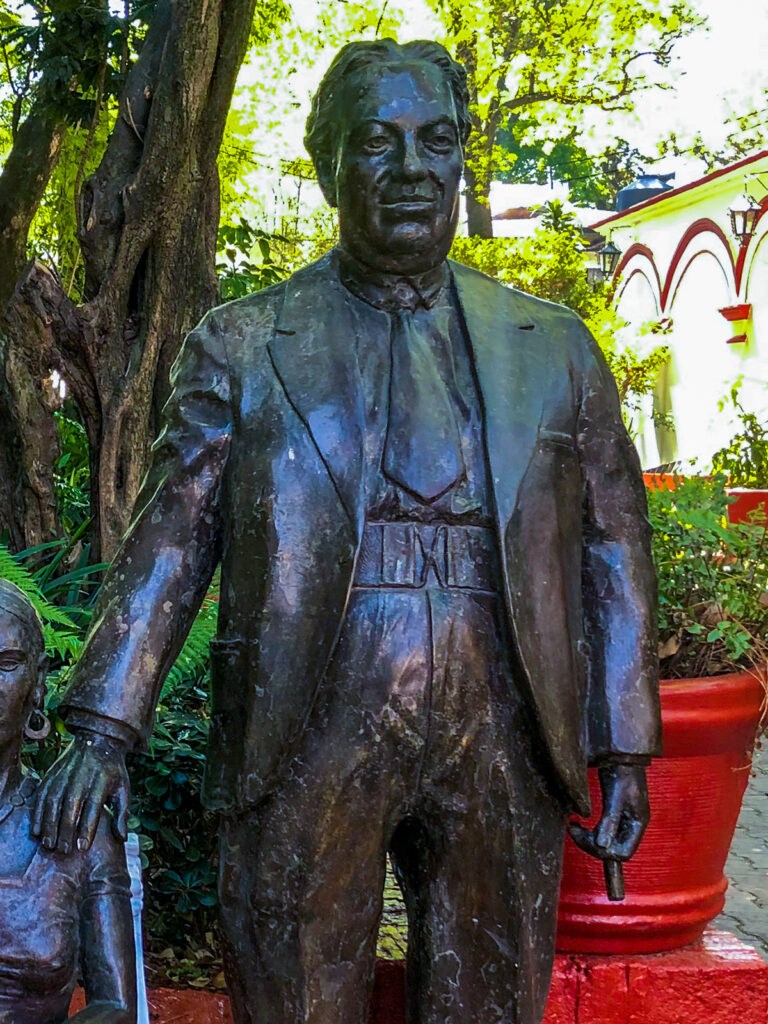
About Diego Rivera
Diego Rivera was born, along with his twin, in Guanajuato, Mexico, in 1886. Sadly, his twin brother died only two years after they were born. Even at such a young age, his twin’s loss significantly impacted Rivera. Perhaps this event created the storm of passion, artistry and creativity Rivera was known for. In fact, it was after his brother died that Diego began to paint. Perhaps as a means to deal with his grief.
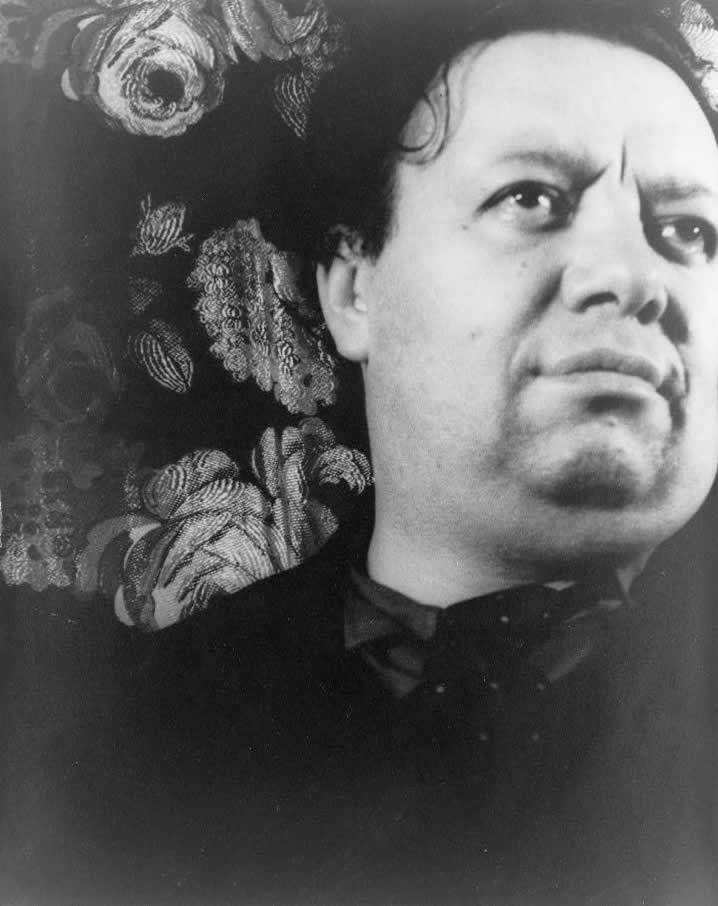
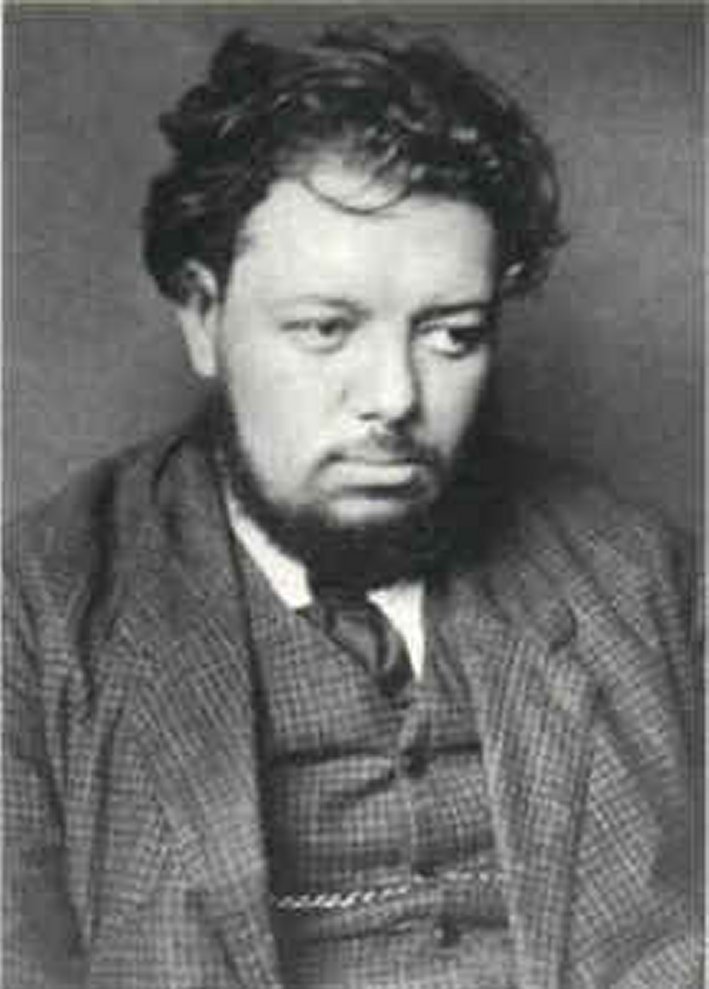
Early Education & Artistic Career
Diego began art studies at the Academy of San Carlos in Mexico City at ten years old. The school was located in the heart of the city’s historic centre. The spark of creativity was ignited when he left his small town and studied in the big city. Diego was so talented that the school sent him to study in Europe. All of the greats were sent to Europe as it was seen as the centre of artistic creations.
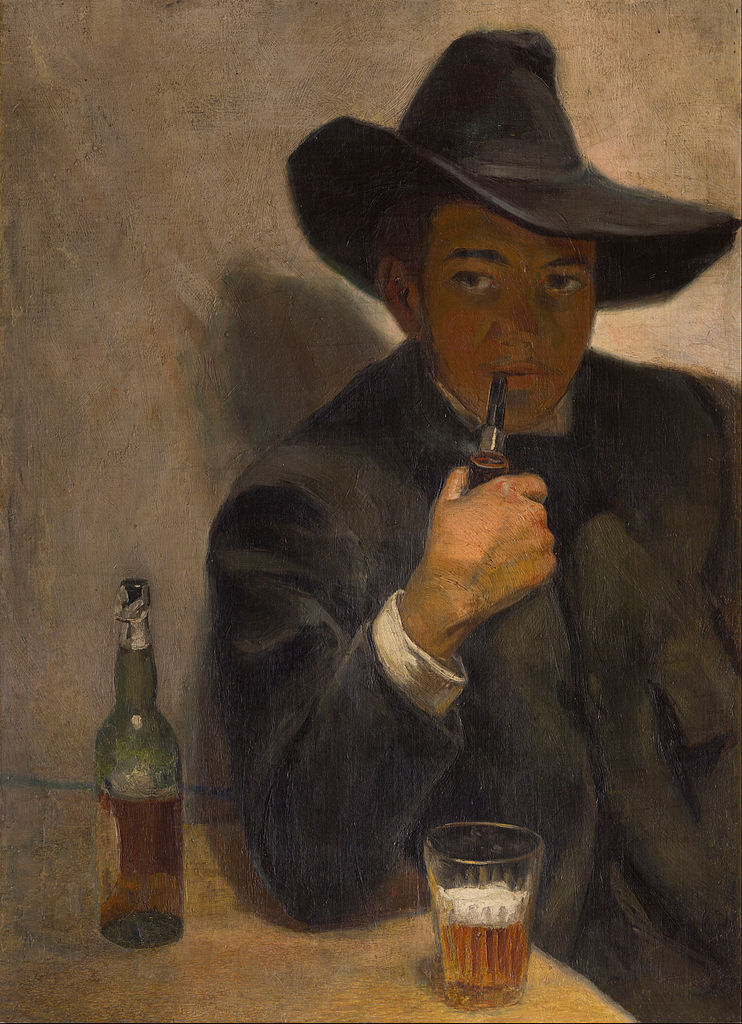
Diego first studied in Spain, and after success there; he went to study in the pinnacle of art cities; Paris. Rivera loved Pars and lived there for years. He was inspired by the work of artists such as Pablo Picasso and Georges Braque. He immersed himself in the immerging style of Cubism and Paul Cézanne’s post-impressionism. From all these inspiring artists, Diego began to incorporate bolder colours, simpler forms and even abstract elements into his painting. This new style of painting demanded the viewer’s attention. Some paintings scream; they do not whisper. And Diego wanted his art to cry out.
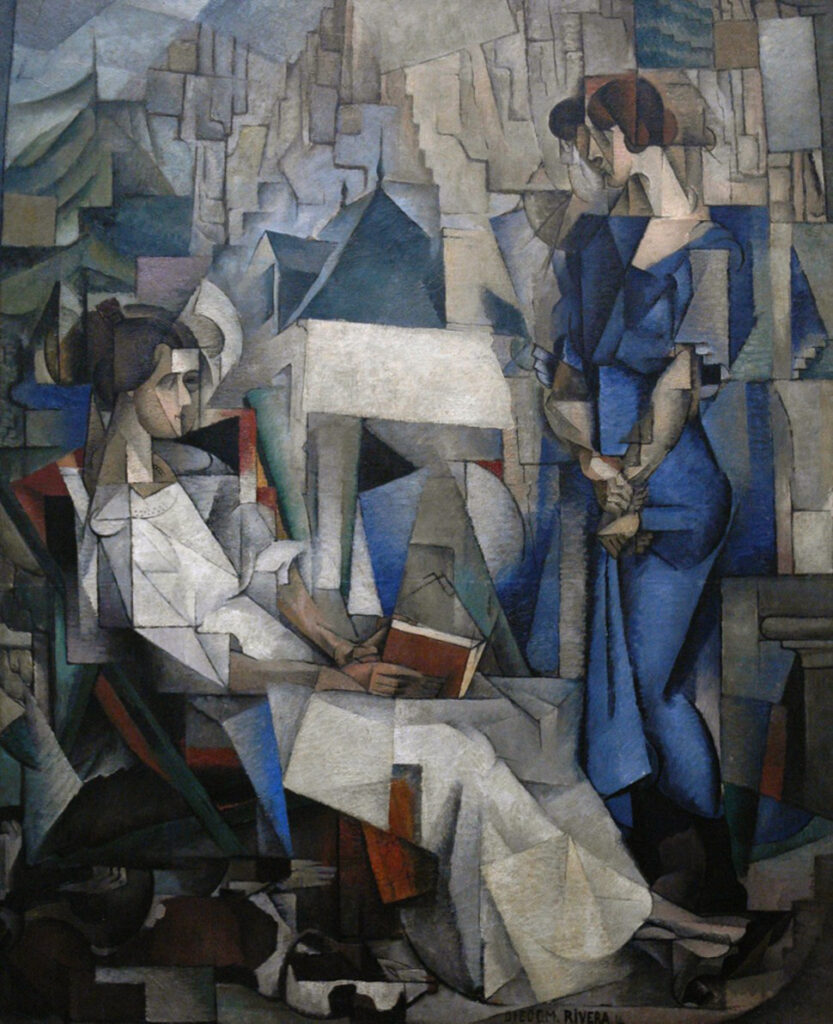
Diego’s Love Life
It was in Paris where Diego met his first wife, Angelina Beloff. A fellow artist from Russia. Despite his atypically handsome appearance, Diego was a lothario. Always with a woman wed and a different one in his bed. During his marriage to Beloff, he was also in a relationship with Maria Vorobieff-Stebelska. Maria would give birth to Marika, Rivera’s first daughter.
Rivera divorced Beloff when he moved back to Mexico City in 1922. Soon after arriving back in Mexico, he met and married Guadalupe Marín. The new couple had two daughters together, named Ruth and Guadalupe.
Diego and Frida
But their relationship also didn’t last, as he was already having another affair with young Frida Kahlo. He divorced Guadalupe Marin in 1929 and married Frida a few months later. He was 44 years old, while she was just 22. Frida and Diego were like fire on fire. Both with huge personalities and huge tempers. But their tumultuous relationship fueled their art. They were both unfaithful during different parts of their marriage. But even these extramarital companions couldn’t soothe the wounds they caused each other. They eventually divorced in 1939. Only after Frida’s death in 1955 did Rivera marry again. This time to his long-time agent, Emma Hurtado.
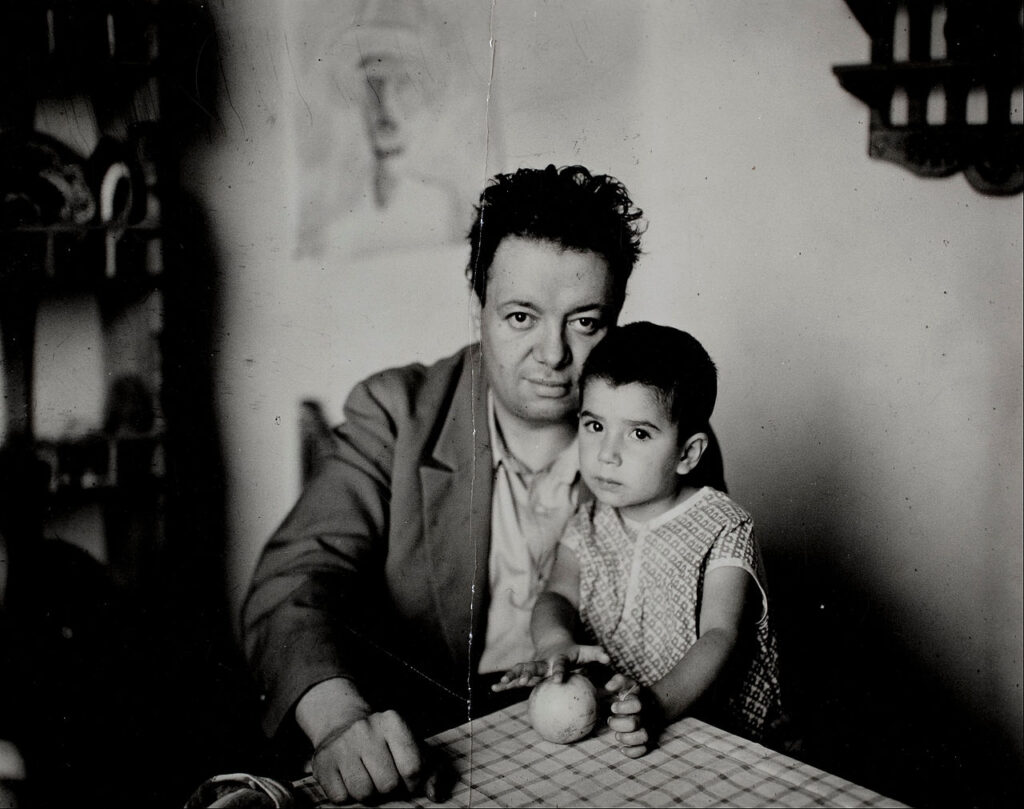
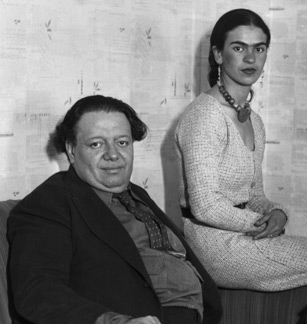
Mexican Muralism
Diego is best known for his work in the Mexican Muralism movement. When he returned to Mexico City, it was under the influence of the Mexican ambassador to France, Alberto J. Pani. The new Mexican Minister of Education, José Vasconcelos, was undertaking a new program of government-sponsored Mexican murals. These murals would be installed all over cities across the country. It was the government’s attempt to reunify the country post-Mexican revolution. The murals were meant to promote political ideas, depict real Mexican society (the good and the bad) and reflect views of the social revolution. To help those who could not read or attend school learn their history.
Rivera’s Unique Style
The three artists who undertook this project were called “the big three” or “The Three Greats.” The group was composed of Diego Rivera, José Clemente Orozco and David Alfaro Siqueiros. Through these murals, inspired by the national identity of Mexico, Rivera developed his iconic native style. This style was based on large, simplified figures and bold colours with an Aztec influence. It is this style that made Diego an icon and gave Mexico its own national art style.
Rivera became so popular that he was called to the United States to bring his style of mural painting to public buildings in the US. He spent a few years working in the US until a disagreement with the Rockerfellers on a large commission fueled his charge back to Mexico City. He continued working on some of the most important commissions of his life until his death on November 24, 1957. After this death, the government of Mexico declared Rivera’s works as “monumentos historicos” due to their importance in the country’s art history.
Start of the Tour: El Cardenal
To start your morning exploring Mexico City in the footsteps of Diego Rivera, you MUST book yourself brunch at El Cardenal. Inside the restaurant is a domineering mural, an artistic replica of one of the most famous Rivera murals. Sitting under a work of art is a great way to bask in its glory while enjoying some delicious Mexican cuisine.
El Cardenal is located inside the Hilton Reforma Hotel. But originally, the hotel which stood in this place was the Hotel del Prado. The Hotel del Prado was built in 1946 as one of the most luxurious hotels in the city. To cement the hotel’s status as one of the top-tier establishments, they hired Diego Rivera to paint a mural inside their new dining room. Sadly, almost nothing of the old hotel remains, as the Hotel del Prado collapsed after the infamous 1985 Mexico City earthquake. The only thing pulled from the wreckage was the mural, which miraculously could be salvaged. The original mural was moved into the nearby Museo Mural Diego Rivera. But this artistic reimagining was made for the new hotel dining room to keep the same spirit of the original.
Dining at El Cardenal
El Cardenal is a small chain of restaurants found all over the city. Their mantra is preserving national folk cuisine and putting it forward for guests to enjoy. Diego himself loved to eat. Although he wasn’t a great cook, food was a major part of his life. Diego and Frida would frequent the marketplace to draw inspiration. And, before leaving, I would fill up on ingredients to bring home. Famous, Diego would end each night with a late supper of hot chocolate and pan dulce. One of his favourite meals that Frida would make for him was a chicken mole. He loved traditional Mexican cuisine and was passionate about preserving it. And this restaurant is the perfect place to enjoy so many traditional dishes.
Museo Mural Diego Rivera
After breakfast, head over to the Museo Mural Diego Rivera. Despite being called a “museum,” the Museo Mural Diego Rivera is simply one large room designed to house the preserved mural from the Hotel del Prado. Thankfully admission is just over a dollar, so it’s more than worth a visit! After the devastating 1985 earthquake, the mural was saved (in pieces) and moved to the museum. Here, it was reassembled with care and restored to as close to its original condition as possible.
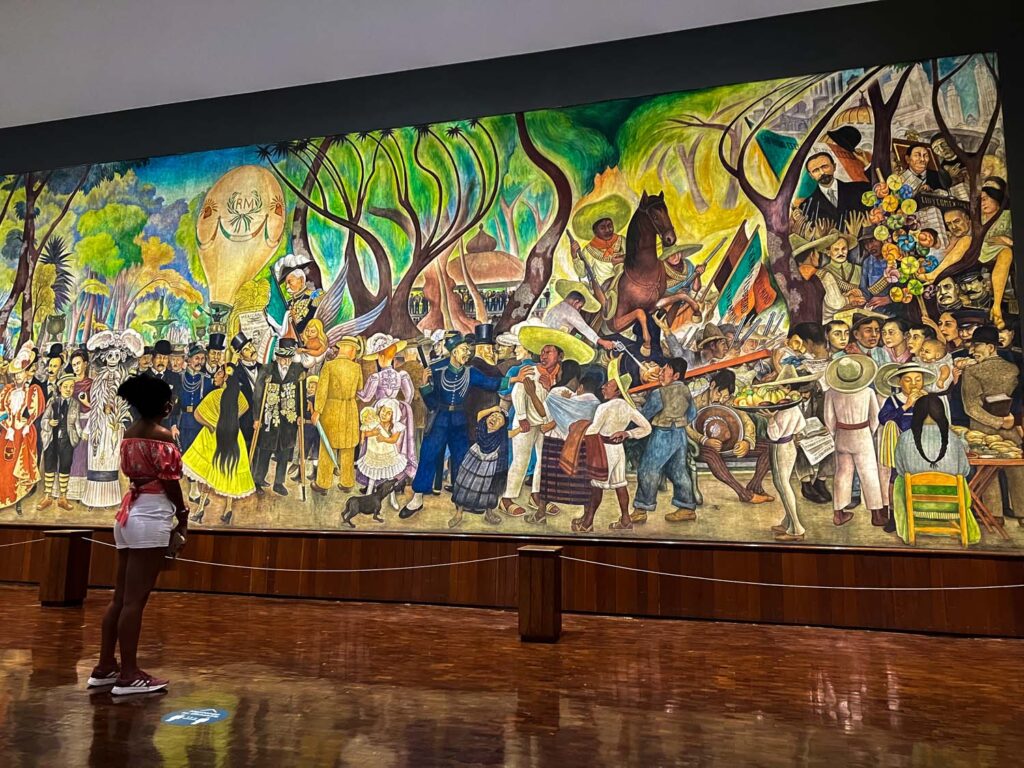
Dream of a Sunday Afternoon in the Alameda Central
The mural is called Sueño de Una Tarde dominical en la Alameda Central (or Dream of a Sunday Afternoon in the Alameda Central.) The exquisite mural spanned over 15 meters wide and was painted in 1947. The setting of the painting is, as mentioned in the title, Alameda Central. Alameda Central is a nearby park that has been a gathering place for locals for hundreds of years. The park was built in 1592 under the order of Viceroy Luis de Velasco II. It is now considered the oldest public park in the Americas. But long before it was a public city park, the area was an important site for the Aztec community. It was here where they held their enormous marketplace long before Spanish colonization.
Alameda Central
Alameda is from the Spanish word “álamo,” which means “grove of poplars.” The poplar trees that were once spread out through the park sadly do not remain today. Today, the trees have been replaced by ash, chestnut and willow trees. The group pictured in the park is filled with historical caricatures from over 400 years of Mexican history. They have all gathered together in this dream of Rivera’s. Although the dream sometimes feels more like a nightmare. Many historical paintings are told by the victors. Therefore they scrub away the sins of their past. But Diego, in all his works, never shied away from showing the grim realities of life. Violence and corruption permeated the history of Mexico.
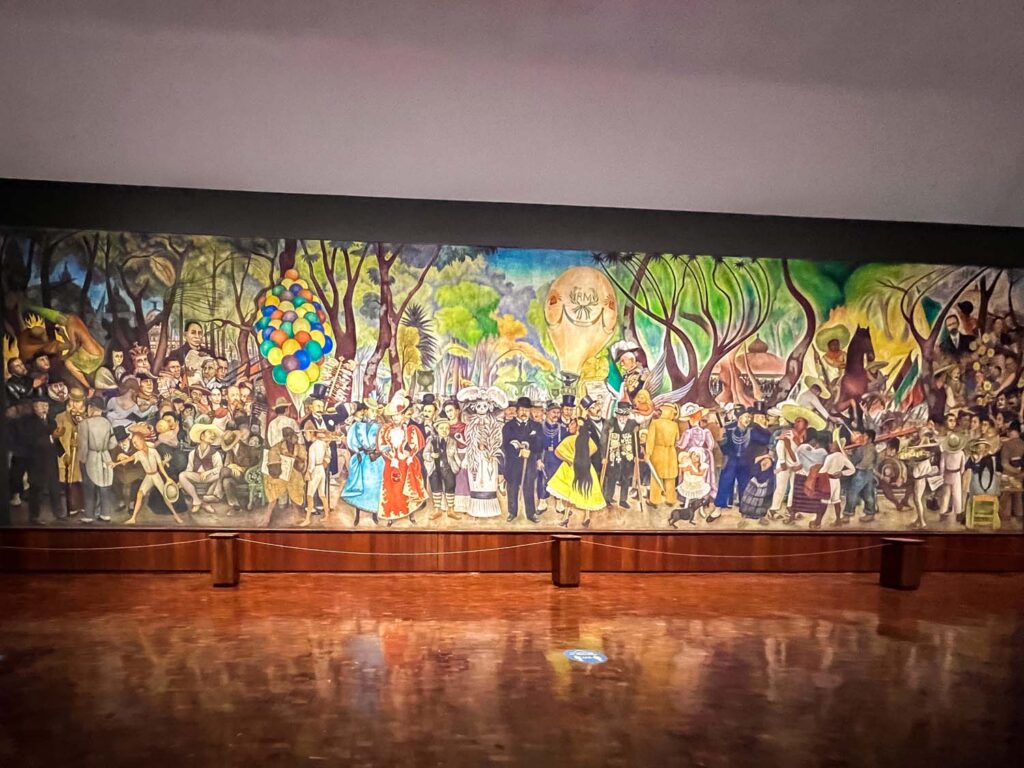
Left Side of the Mural
The scenes from the painting can be read chronologically from left to right. You can get right up close to the mural in the museum to view these life-sized figures. Getting so close lets you feel the energy depicted within the scene. The piece seems to reverberate; gunshots fire, horses rear, police seize innocent indigenous children and the echoes of revolution swell in the background.
Hernan Cortez
One of the first figures of note to find is Hernan Cortez. You can see him off on edge to the left, dressed in his traditional military armour. His hands are posed in prayer as he is posed in front of flames that burn behind him. The flames of war he ignited. Beside him are victims of the Spanish Inquisition. Priests can be seen brutally punishing the victims, and a man all in black is in mid-swing of his cat of nine tails whip. One of the victims wears a sanbenito robe and conical hat. The iconic hat is now sometimes referred to as a “dunce cap.” The garments were worn by penitent heretics before they were put to the auto-da-fé. This “act of faith” was a ritual of public penance where the victims were killed by burning.
Below the large tree on the left, you can see two generals facing each other. The general on the left with the feathered admiral hat is Mexican president López de Santa Anna. Beside him is American General Scott. In 1846, during the presidency of López de Santa Anna, the Americans invaded Mexico City. And their encampment was actually located right inside Alameda Central.
Benito Juárez
Despite being farther into the background, the image of Benito Juárez, president of Mexico, is almost the largest face on the entire left side. He is seen holding a series of papers in his hands. Benito Juárez was President of Mexico from 1857 to 1872. During his time in office, Mexico suffered a second struggle for independence, a second defeat for the European powers, and a second reversal of the conquest. His greatest legacy was signing the Juárez Law, which declared all citizens equal before the law and restricted the privileges of the Catholic Church and the Mexican army.
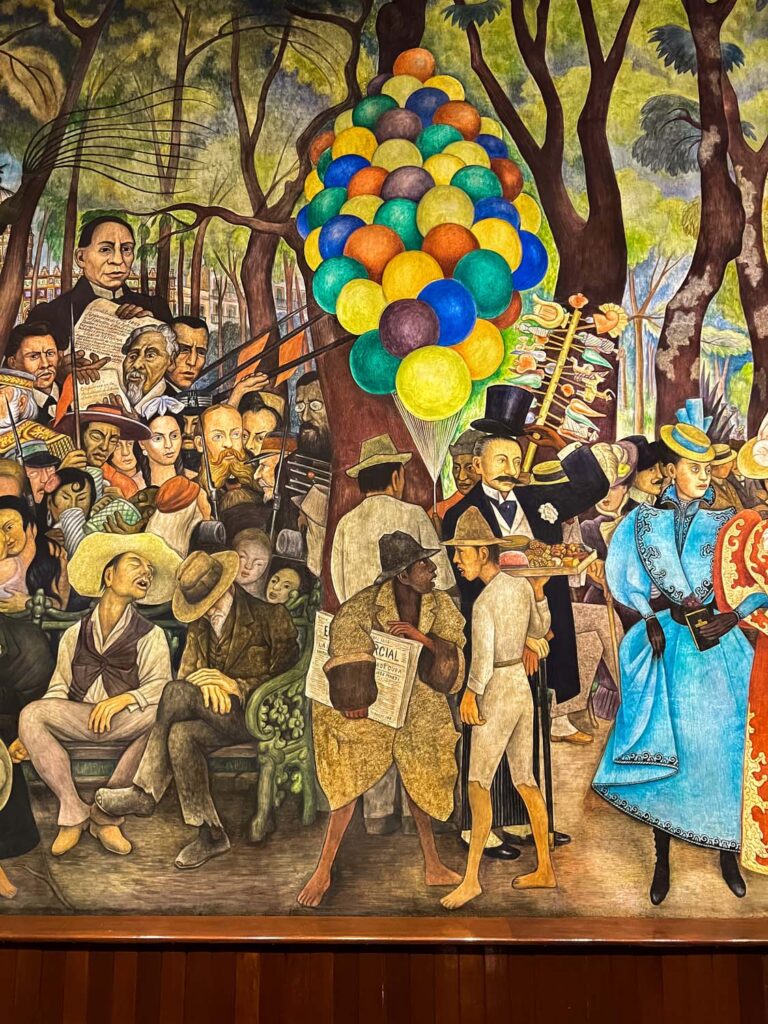
Center Mural
The centre of the frame is the most vibrant and dreamlike part of the painting. It features bourgeois men and women in their Sunday best. In the background, the lush tropical park with a large fountain seems to glow with almost an ethereal neon hue. Above the scene in the centre is a huge hot air balloon flying above. The balloonist waves his Mexican flag, and the balloon is emblazoned with the Mexican Republic insignia.
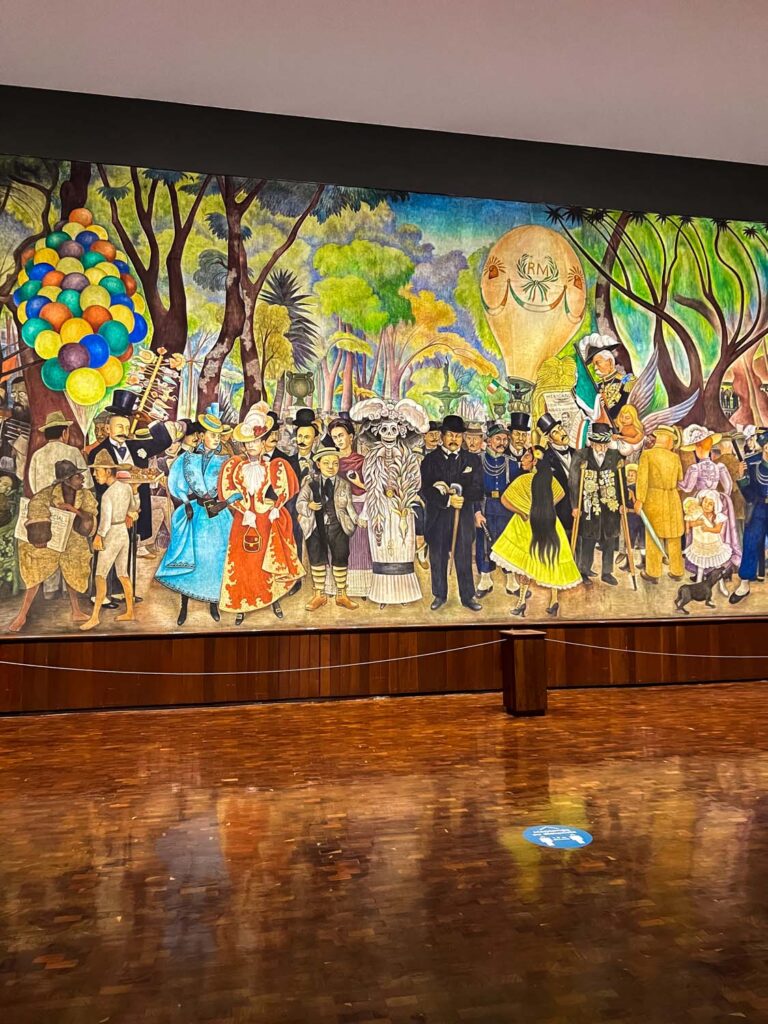
La Calavera Catrina
The centre is dominated by a large, white skeletal figure called La Calavera Catrina. La Calavera Catrina (also called ‘the Dapper Skeleton’ or ‘elegant skull’) was originally conceived as a black and white cartoon. It was first drawn in 1910 by illustrator and lithographer José Guadalupe Posada. Rivera actually portrays Posada in this mural as well. He is seen to the right of La Calavera Catrina, holding her arm under his.
Originally, La Calavera Catrina was meant to be a caricature. She represented the elite of Mexico City during the reign of Porfirio Diaz. The caricature symbolizes a Mexican woman who has given up her Mexican culture and adopted high-society European aesthetics. Depicted with her huge Europe-styled hat and expensive feathers. And yet the woman is a skeleton. As if to say that no matter how you see yourself in this world, we are all the same underneath it all. Just bones. Over the years, La Catrina has become the symbol of death in Mexico. Her visage is a traditional part of the Day of the Dead celebrations.
Rivera’s Calavera Catrina
In Diego’s mural, he has given the original sketch a whole body. While the face and large hat mirror the original drawing to a T, Diego has added some new elements. This includes a sumptuous feathered boa that hangs around her neck. But if you look closely, you’ll see the feathered boa still has a head and tail. This is meant to represent the Aztec serpent god Quetzalcóatl. Around her waist, La Calavera Catrina wears a belt with a gold buckle in the shape of an old Aztec symbol. This symbolizes La Calavera Catrina’s transition from caricature to a new form of revered god in the people’s eyes. She wears the body of the old god around her neck as she steps in to take its place.
Young Diego
In La Calavera, Catrina’s other hand, she holds the hand of a young Diego Rivera. Rivera has a playful little smile on his face. You can see a small toad poking out its head in his breast pocket, and in his other pocket, out comes a green snake. The umbrella he holds in his hand has the face of a bird, perhaps the Crested Caracara, often referred to as the “Mexican Eagle.”
Frida Kahlo
Directly behind Diego stands Frida Kahlo. Frida’s hand lovingly rested on Diego’s shoulder. She holds a medallion with the yin-yang symbol in her opposite hand. Famously, Diego and Frida were polar opposites, yet they were drawn to each other despite these differences. In Chinese philosophy, the symbols depict the fundamental duality in humanity: female (“Yin”) and male (“Yang.”) Both Frida and Diego frequently painted images of each other in their artworks. In each of these paintings, there is always a coded message about the state of their relationship.
Throughout Diego’s career, Frida was always thought to be working in Diego’s shadow. She was known more as “the wife of Deigo Rivera” rather than an artist in her own right. And yet, here she is, the elder partner. Seemingly guiding Diego with her hand on his shoulder. Frida’s health was declining fast when Rivera painted this mural. Perhaps his small stature in the painting also reflects his helplessness in the face of her impending death.
Right Side of the Mural
To the right of the central group, we can see Porfirio Díaz looking down on them. Dressed in his military uniform and feathered hat, his decerning eyes gaze angrily at the group gathered. Díaz served seven terms as the President of Mexico. But this was better known as a dictatorship in the later years. Díaz started out as someone who aimed to turn the country around and free the people from the French. But once he came to power, his policies only benefited his circle of allies. The peasantry did not share in Mexico’s prosperity, leading to the Mexican Revolution of 1910.
Below Díaz, on the ground, we see an indigenous family being forced to leave the park. They are being pushed away by a series of police officers. This is how Rivera uses transparency in his art. He aims to depict the racism that even the Mexican people have towards their indigenous community.
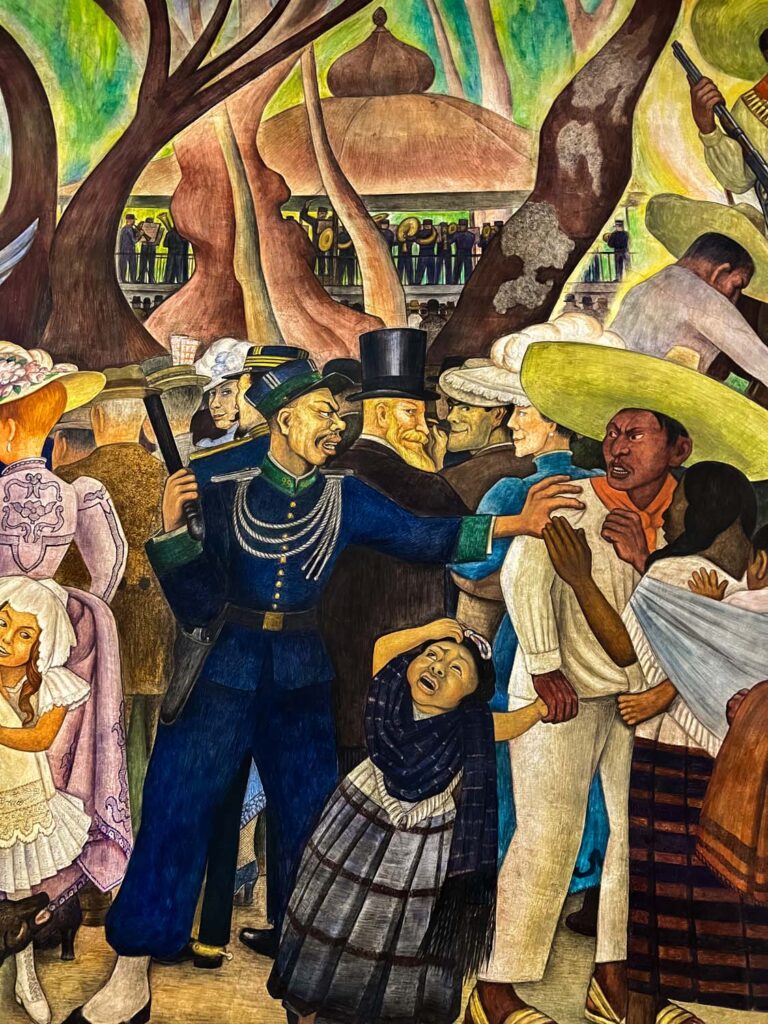
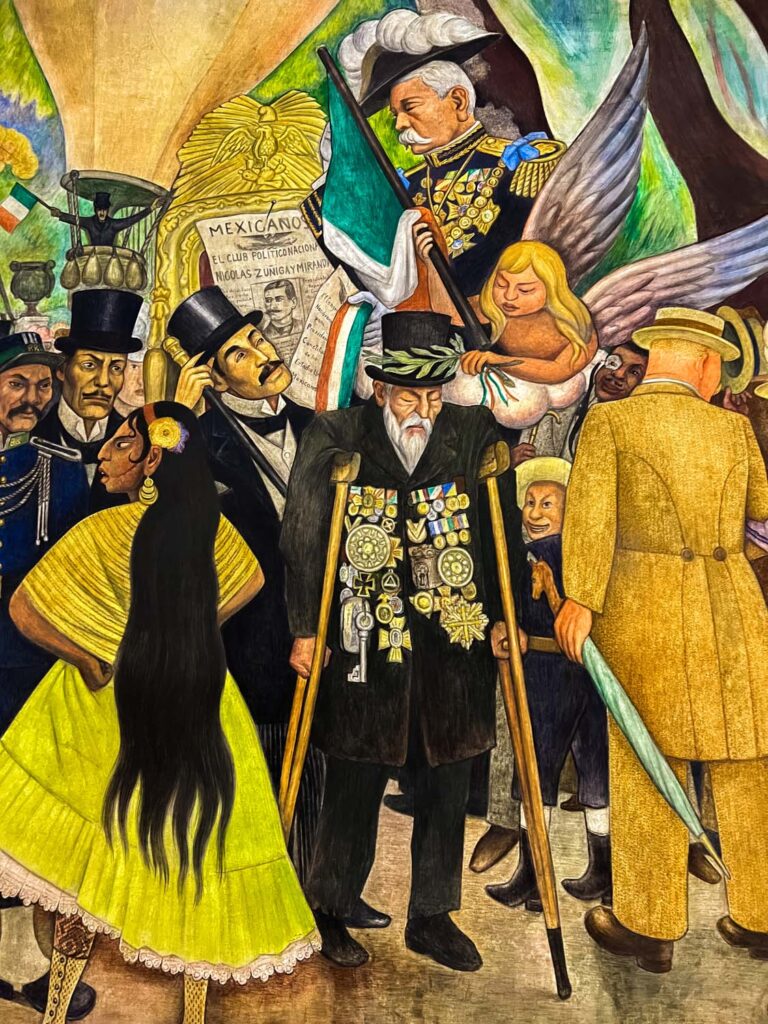
Francisco I. Madero
On the far right, up in a tree in front of a large Mexican flag, we can see Francisco I. Madero. He is smiling and waving his black hat up in the air. Madero was the head of the movement that overthrew Porfirio Díaz. Sadly, Madero was murdered during the Ten Tragic Days of 1913. His murderers, General Victoriano Huerta and Manuel Mondragón are also portrayed in the mural. Their menacing grey faces with prominent mustaches are hidden behind the crowd in the lower right corner.
Also in the lower right corner are a group of women important to Rivera. This includes his ex-wife Guadalupe Marín, his daughters Guadalupe and Ruth Rivera Marín and his great friend Rosa Rolando Covarrubias. In the arms of his daughter Guadalupe, she holds her young son Juan Pablo. Perhaps by depicting his grandson in the photo, Diego wanted to cap the mural off with an image of hope. Hope for the future and for a better world for his grandson.
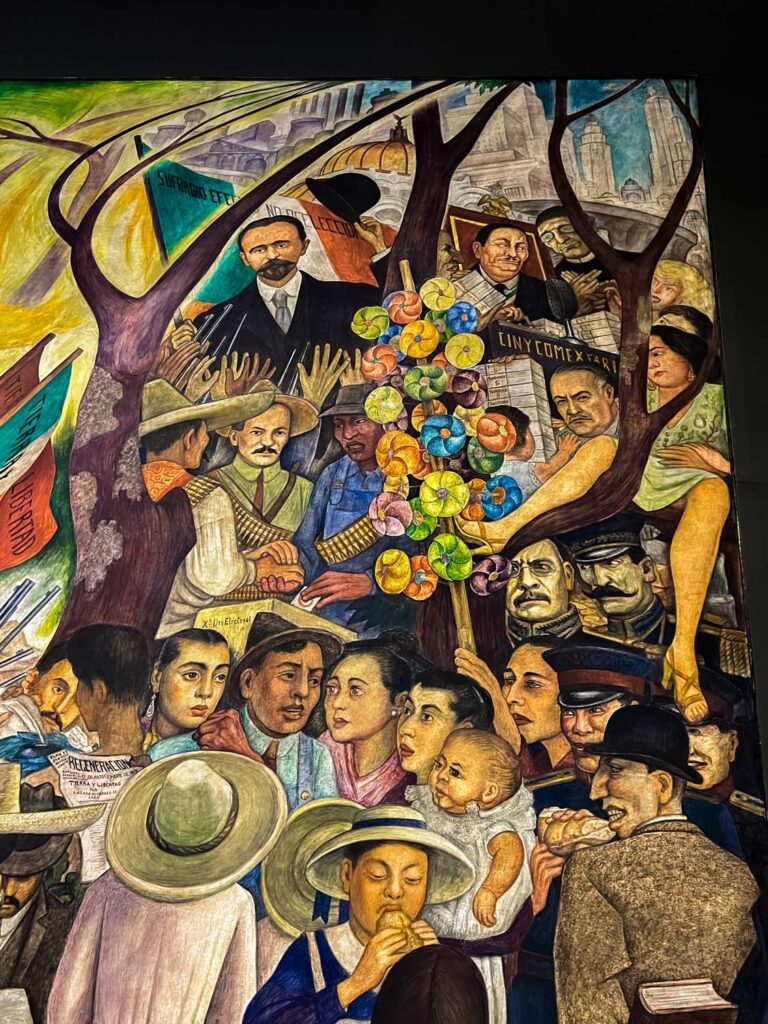
Alameda Central
After touring the museum, take a walk in the actual Alameda Central. Strolling through the gardens, monuments and pathways, you can get a sense of the vibrant atmosphere that must have inspired the setting for Rivera’s artwork. While the eastern portion of the park was for leisurely promenades, the park’s west end held a more nefarious purpose. This western section was originally built during the Mexican Inquisition. It was known as the “Burning Place.” Here, convicted witches and people accused of treason were publicly burned at the stake. While you don’t immediately think of Mexico as a place of witch trials, these inquisitions spread worldwide. When the inquisitions ended in 1770, the burning plaza was destroyed and transformed into an extension of the park.
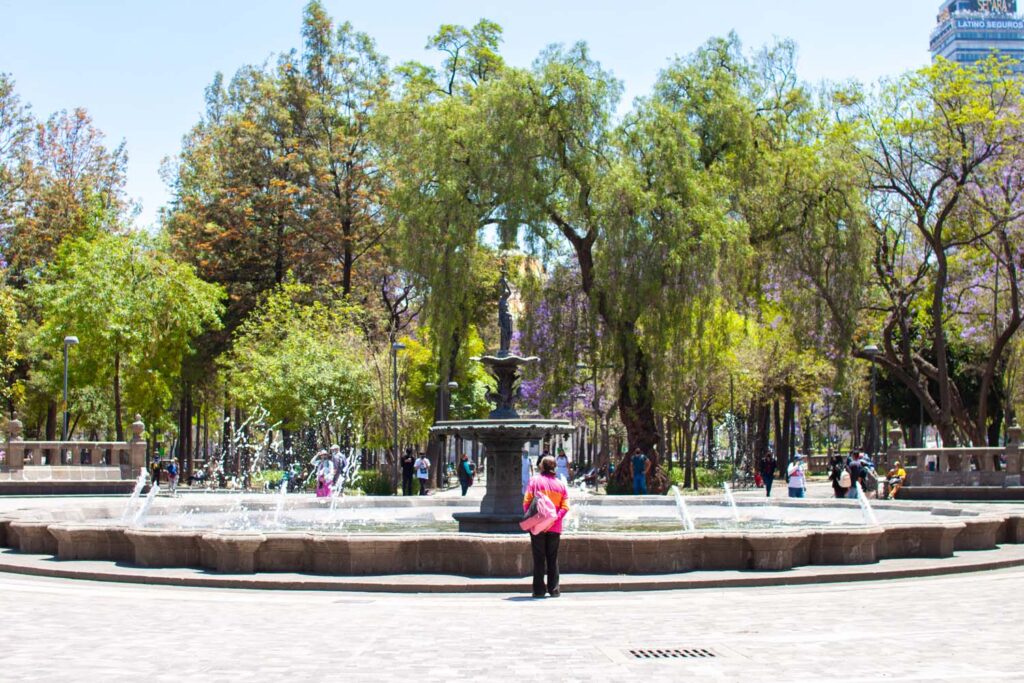
One of the most important monuments is the “Hemiciclo de Benito Juárez.” This large semi-circle of eight towering marble columns with a central plinth is topped with a group of neoclassical statues. In the center is statesman Benito Juárez himself. Juárez was the 26th president of Mexico and, most importantly, the first president of Mexico of indigenous origin. On either side of him are two allegorical female statues representing the fatherland and law. On the pedestal he sits, you can see the inscription “Al benemerito Benito Juárez la Patria.” This translates into “To the meritorious Benito Juárez, the Homeland.”
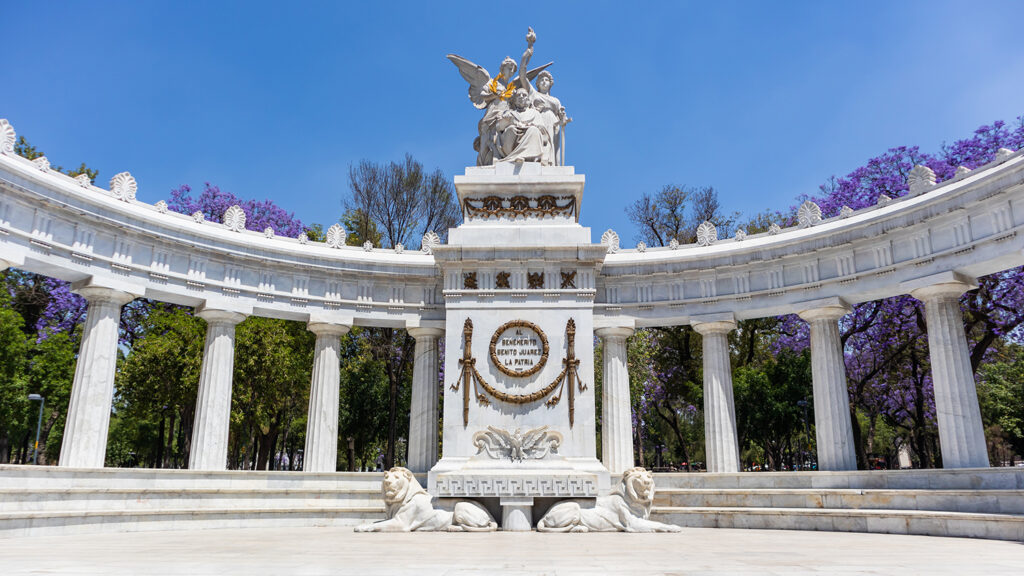
Palacio de Bellas Artes
The Palacio de Bellas Artes, with its iconic sunset tiled roof, is one of the most iconic images of Mexico City. The Palacio de Bellas Artes hosts music, dance, theatre, opera and literature and is aptly named the “Cathedral of Art in Mexico.” The exterior of the building is primarily Neoclassical. But inside, you’ll discover a plethora of modern Art Deco and Art Nouveau stylings. Adding to the incredible decor of the interior is a series of murals wrapping around the walls. Each of these murals was commissioned by star painters of the Mexican Muralism movement. This includes; José Clemente Orozco, David Alfaro Siqueiros, Jorge González Camarena, Roberto Montenegro, Manuel Rodríguez Lozano and (most famously) Diego Rivera.
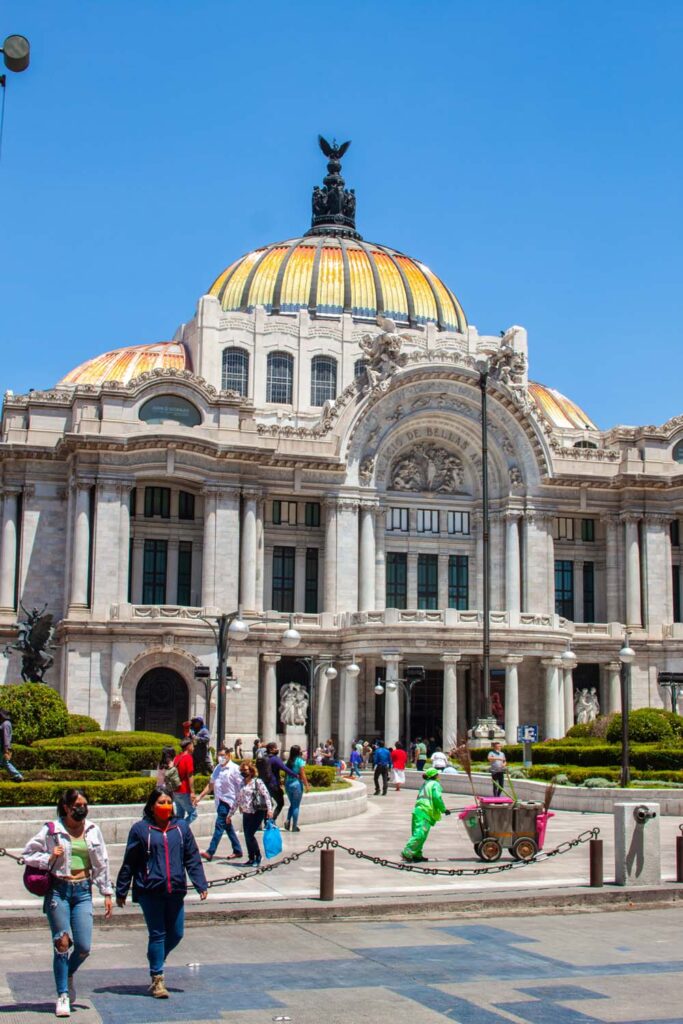
Man, Controller of the Universe
On the 3rd floor is where you can find Diego Rivera’s Man, Controller of the Universe. The mural is a recreation of the original mural once painted for New York City’s Rockefeller Center in 1933. When it was first thought up by Rivera, he named it Man at the Crossroads. But halfway through the project, the Rockefellers and Rivera disagreed about the subject matter depicted in the mural. The piece was meant to represent aspects of contemporary social and scientific culture. While the Rockefellers loved Rivera’s work, a damning article by the New York World-Telegram called the mural “anti-capitalist propaganda.”
Rivera and Lenin
Rivera was furious by the statement. As a means of revolt, he added a portrait of Lenin hidden within the mural. This portrait had not been approved in his original sketches. But Rivera hoped it wouldn’t draw any attention by hiding among other large portraits. Unfortunately, right before the unveiling, the Rockefellers took notice and demanded it is painted over. Rivera refused, and the entire piece was destroyed. This was a massive blow to Rivera’s ego. He was quoted as saying, “Rather than mutilate the conception [of the mural], I shall prefer the physical destruction of the conception in its entirety, but preserving, at least, its integrity.”
After its destruction, Rivera recreated it in Mexico City on a blank wall in the Palacio Belles Artes. Rivera had asked his assistance to take pictures of the original mural before it was torn. This ensured he could recreate it perfectly here at the Palacio Belles Artes. When he was finished, he named this version Man, Controller of the Universe. A much more powerful title and reflective of his overall worldview.
Reading the Mural
The mural is split up into three different sections. In the center is a workman turning a giant piece of machinery. As if he is controlling the world around him with this machinery. Rivera was a staunch atheist, and his idea of man being the controller of his own destiny, not god, is evidently presented here. On the right side of the mural are depictions of capitalism, and on the left are depictions of communism. As mentioned in the original title, the universe appears at a crossroads. And we don’t know which way the man in the center will turn the wheel…
Central Mural
Emerging from the lower portion of the workman’s body is a giant fist. In the tight grasp of the fist, we can see an orb. Inside the orb are images of atoms and cells dividing in the act of chemical and biological generation. An ethereal blue light glows from around the edge of the orb. And tendrils start to emanate and spread out onto the rest of the image.
Radiating from behind the man is a series of propeller-like shapes. Inside each shape are images on both the micro and macro levels. Images as far away as the cosmos or as close up as bacteria are all seen through a microscope. Rivera is telling us that man can see it all. Beneath the mechanical structure, you’ll notice a small garden growing. This is meant to represent Mexico’s controlled growth of rich natural resources.
Left Side of the Mural
To the mural’s left side, we can see a small grouping of high society women playing cards and smoking. Hidden within the group of women, Rivera painted a portrait of John D. Rockefeller. Painting him among the clueless and cruel elite was revenge for Rockefeller destroying Rivera’s mural in New York.
Outside of their “social circle,” just beside the elite, are the faces of haggard workers looking on. Exhausted, angry expressions paint their faces. Above them, riots roars and police on horseback swing their batons, trying to silence protesters. This is a harsh contrast to the carefree gambling parties on the right. They are entirely unaware of the reality of the world around them inside their bubble.
Charles Darwin
In the foreground, a group of students of different ethnic backgrounds sit in lecture chairs. They appear to be watching the scene unfold through the large oculus in front of them. They are the hope for tomorrow, and only through learning about the past will they shape a better future. To the students’ left, we can see an x-ray machine controlled by a timid bearded man who represents Darwin. He is surrounded on the floor by different animals, which his studies revolve around.
Above the group stands a giant classical marble statue of the Greek god Jupiter. He looks furious, raising his hand to the sky. But a thunderbolt appears to strike his hand and break it from the rest of the statue. Around his neck is a large wooden cross. Rivera points out how Christianity and the Greek gods were false and would be destroyed by this new world. For Rivera, past myths have no influence on the future, where science and our understanding of the natural world around us reign supreme.
Above the entire scene is an assemblage of faceless soldiers and war machinery. Each soldier wears a terrifying gas mask on their face, obscuring their identity. Above the soldiers, the sky is filled with planes against a blood-red sky. A comment from Rivera on the violence created by capitalism.
Right Side of the Mural
While the left side seems focused on war, the right side is a socialist utopia. On the right, between the propellers, we can see that famous image of Lenin. The very same one, the Rockefellers, were so up in arms about. In Lenin’s hands, he holds diverse workers around him. To the left of the group with Lenin is one of the brightest parts of the mural. Four women are shown in brilliant white athletic uniforms against a brilliant backdrop. A beautiful symbol of the power and hope Rivera had for women.
Along the top edge of the right mural are a large group of men and women celebrating the Russian May Day rally. Each wears a red cap or scarf and flies flags to symbolize communism. On the far right, we see another classical sculpture depicting a seated Caesar with his head cut off. Around Casesar’s waist, he clutches a bundle wrapped with a belt displaying the nazi symbol. Rivera viewed Caesar as a man of material goods. His beheading was a message from Rivera to rid ourselves of these material obsessions.
Leon Trotsky
At the feet of the headless statue is a man with round glasses and white hair. This is Leon Trotsky, a Ukrainian-Russian Marxist revolutionary, political theorist and politician. Trotsky and Rivera were once good friends. Trotsky even came to live in Mexico City after being expelled from the Soviet Union. Despite their best efforts to keep him safe, Trotsky was assassinated in his home in Coyoacán. Trotsky holds a giant red flag, supported by the industrial workers around him, representing Marxist theory. In the bottom left corner, one of the workers can be seen sitting casually on the statue’s head from above.
Stand back and take the entire mural in as one large scene. By doing this, you can appreciate how the left, the capitalist society, feels grim. On the right, more emotions are on the people’s faces, more rich colours. The people on the left are controlled by the government and religious institutions, and only the elite are free. But on the right, communist society is given control and freedom to create its own universe. Controlled by the people.
Diego and Frida’s Funerals
Another big connection that the Palacio Belles Artes has to Diego is that it was the designated location for the funeral of his ex-wife Frida Kahlo. And would go on to be where he would be laid in state after his own death. Diego arranged for Frida’s body to be laid out in the Palacio de Bellas Artes. The government agreed, only if they would make it an entirely non-political event. Diego agreed. But unbeknownst to him, one of Frida’s students came to pay their respects and threw a huge communist flag over her casket. The government threatened to remove her body, but Diego refused to let them. He said if they tried, he would carry her dead body in his arm. And sit with her on the palace’s steps. They reluctantly agreed, and the flag remained on her casket, one last act of defiance.
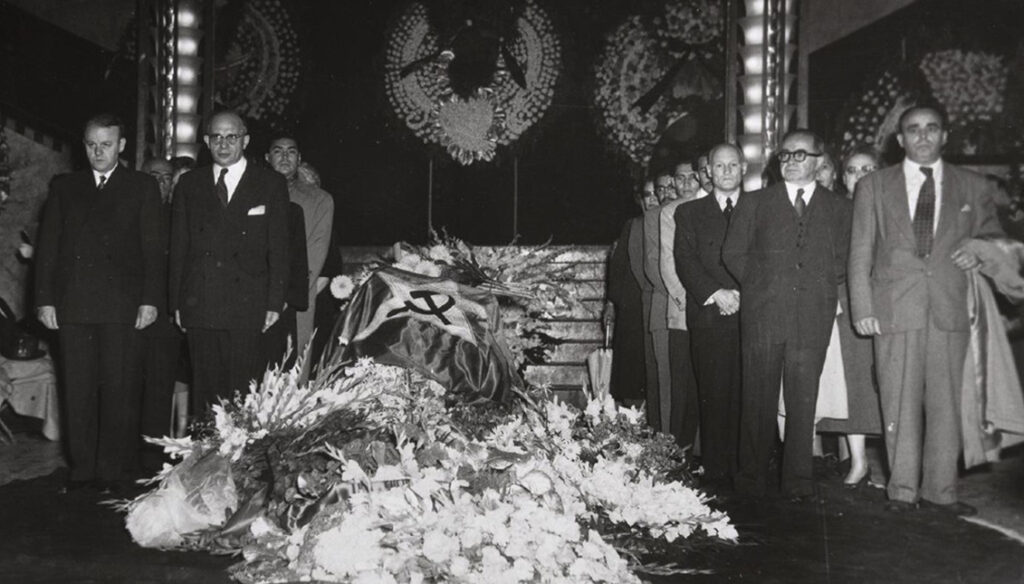
Mexican Secretaria of Public Education Headquarters
Take a walk along the pedestrian-only Av Francisco I. Madero west towards the inner portion of the Historic Centre. When you reach the República de Brasil, head north, crossing westward once more along Luis González Obregón street. A few steps down the street, you’ll immediately see the Mexican Secretaria of Public Education Headquarters. The enormous building is spread over an entire city block. The facades that face out onto the different bounding streets are each done in a unique architectural style. Changing depending on the era in which it was created.
Diego Rivera Murals
Walk inside the iron gates from the República de Argentina to enter the open-air courtyard. You’ll usually see two armed guards on either side of the doors. Since this is still a government office, they take security seriously. Tell them you are there to visit the Diego Rivera murals. The guards will usually let you in if there aren’t any private events. But they might do a quick security check of any bags, so don’t let that surprise you. Inside the doors, you’ll enter the first of two large adjoining courtyards. Covering the courtyard’s walls are 235 panelled murals painted by none other than Diego Rivera. This was Rivera’s first large-scale painting project.
Rivera and Vasconcelos
When Rivera returned to Mexico from his studies in Europe, it was to participate in a new mural program started. The program was the pet project of the new Secretary of Public Education, José Vasconcelos. Vasconcelos thought that art was a powerful tool for education. He went about commissioning large-scale mural projects across the city to bring art to the public. This project took place after the great Mexican revolution. Art was to be used to help communicate to the people that this new government would guarantee the new life promised by the revolution. And the first building Vasconcelos wanted Diego Rivera to work on was aptly the same one he worked in.
Like many of his contemporaries, Rivera believed that easel painting was considered too aristocratic. He and his contemporaries thought large, public murals could reach a larger audience. Art didn’t need to be hidden away inside stuffy museums or only appreciated by those with a critical eye. Art was for everyone.
Education Mural Themes
Rivera started work on the murals in 1923, which took the painter five years to complete. Despite the overly Greek-influenced exterior, these murals focused powerfully on the Mexican identity. The murals followed themes of the Mexican Revolution and the glorification of Mexican labourers. Rivera’s themes are divided by the two courtyards. The larger courtyard focuses on Labour, and the smaller courtyard is dedicated to the Mexican Fiesta. Unlike the European influence that paints the colonial parts of the city, these murals focused on traditional Mexican heritage.
Fiesta Courtyard
The smaller Fiesta Courtyard is the first one you’ll enter. Here there are murals on the ground floor depicting various meaningful events in the Mexican calendar. You’ll see scenes from the Deer Dance, the Day of the Dead and the Corn Fiesta. There are also murals featuring the Meeting on May 1st, Good Friday and the Ribbon Dance.
Walk up the stairs to the second level, where you can view one of the most important of Rivera’s murals. This massive painting, called The Arsenal, portrays a group of revolutionaries preparing for battle. In the center, you can see the image of a young woman in red wearing a communist star on her shoulder. The woman who posed for this painting was none other than Frida Kahlo. He painted her when she was just a student, long before the two would be married. Hovering above the murals, Rivera painted a sprawling red banner. The banners span the entire wall length and connect one scene to the other. The text written upon it is lyrics to various revolutionary songs called “corridos.”
Labor Courtyard
The larger courtyard surrounds a beautiful green garden full of lush foliage. In this area, you can see scenes depicting Mexican labourers. Using looms, you’ll find images of mineworkers, sugar mill labourers, and craftspeople. Women set about dying fabric, smelters work in hot ovens, and busy farmers sell their goods in the marketplace.
On the second-floor staircase are a series of murals highlighting Mexico’s diverse landscape. From the bright blue coastlines to the lush green mountains. The murals on the second level are dedicated to what Rivera considered the four primary elements of painting. These are light, colours, man and geometry.
Former College of San Ildefonso
Head back outside and make your way to the Former College of San Ildefonso, now the Museo De San Ildefonso. As you walk towards the building, take a moment to study the architecture of the building. The ancient blood-red volcanic stones are contrasted with a series of elaborately designed windows. The vibrant stained glass still gleams in the sunlight even to this day.
You walk through the double arcade outside Justo Sierra to enter the building. Stand outside the door for a minute to appreciate the elaborate Neo-Churrigueresque architecture. Neo-Churrigueresque is also known as Ultra Baroque. The style developed primarily in Spain but made its way to their colonies. Here it seemed to find a loving home in the arms of the Mexican people who love decoration. The style is primarily identifiable by extremely expressive and florid decorative details. While these elements bleed into the rest of the building, their main cluster surrounds the entrances and facades.
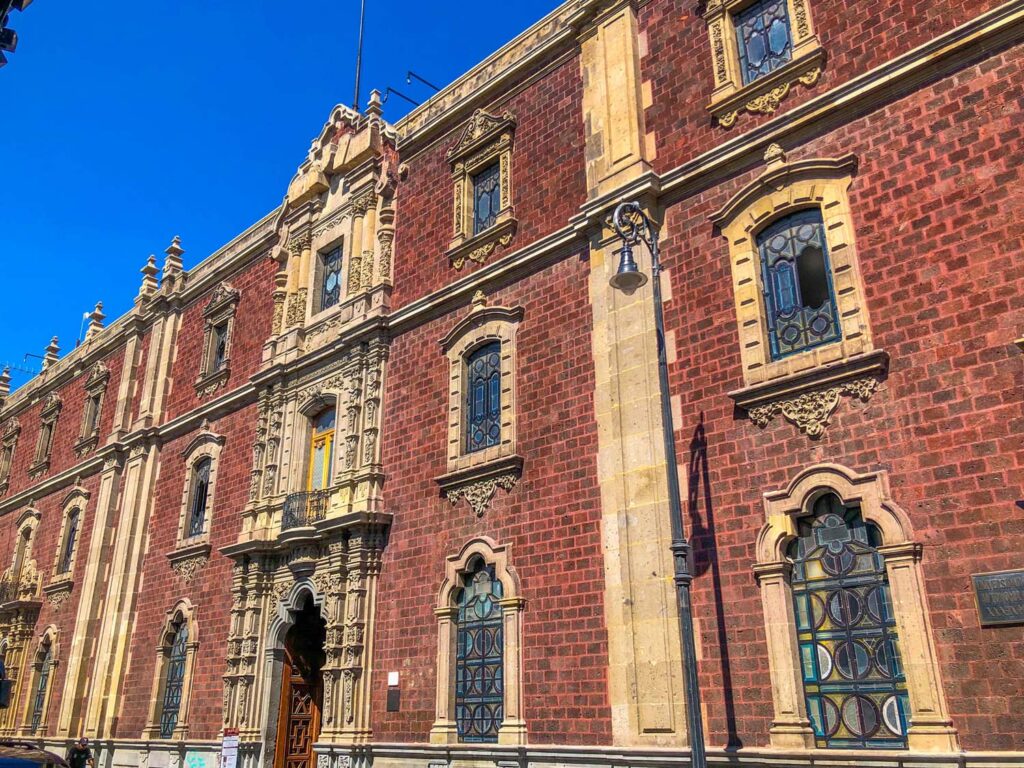
Mexican Muralist Movement
Inside the old college, it’s here that the Mexican Muralist movement was said to be invented. The building was originally constructed in 1588 as a Jesuit College. But when the Jesuits were expelled, the school became a residence for soldiers in 1767. Then, in the 1860s, the building was once more transformed into a school by president Benito Juárez. Juárez took schooling out of the hands of the clergy and into the hands of the government. Back then, the school saw over 700 students in and out of doors daily.
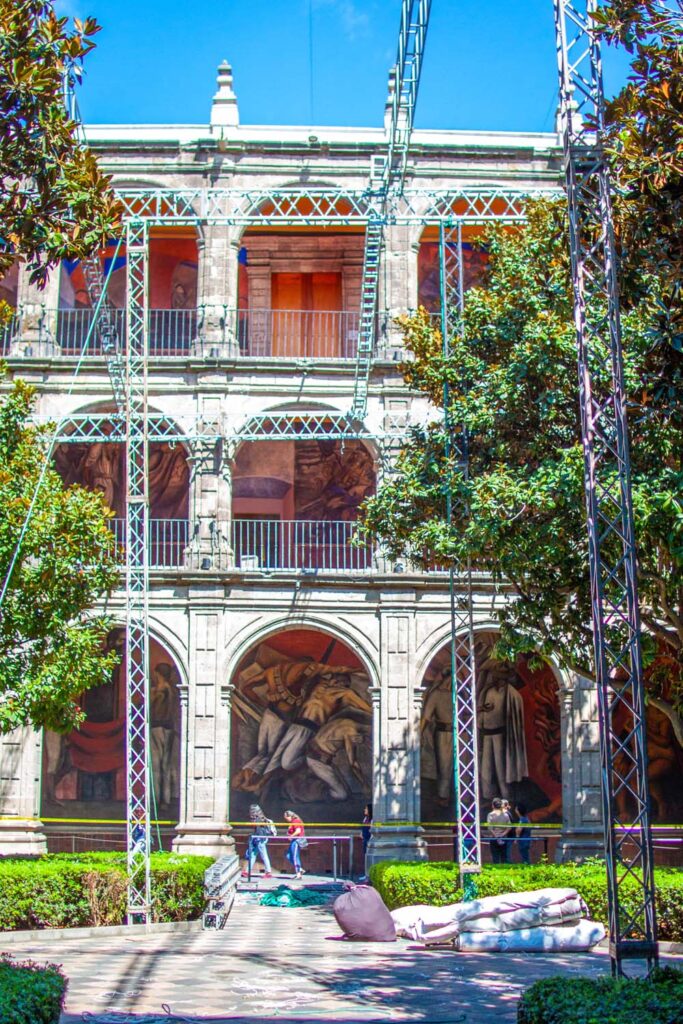
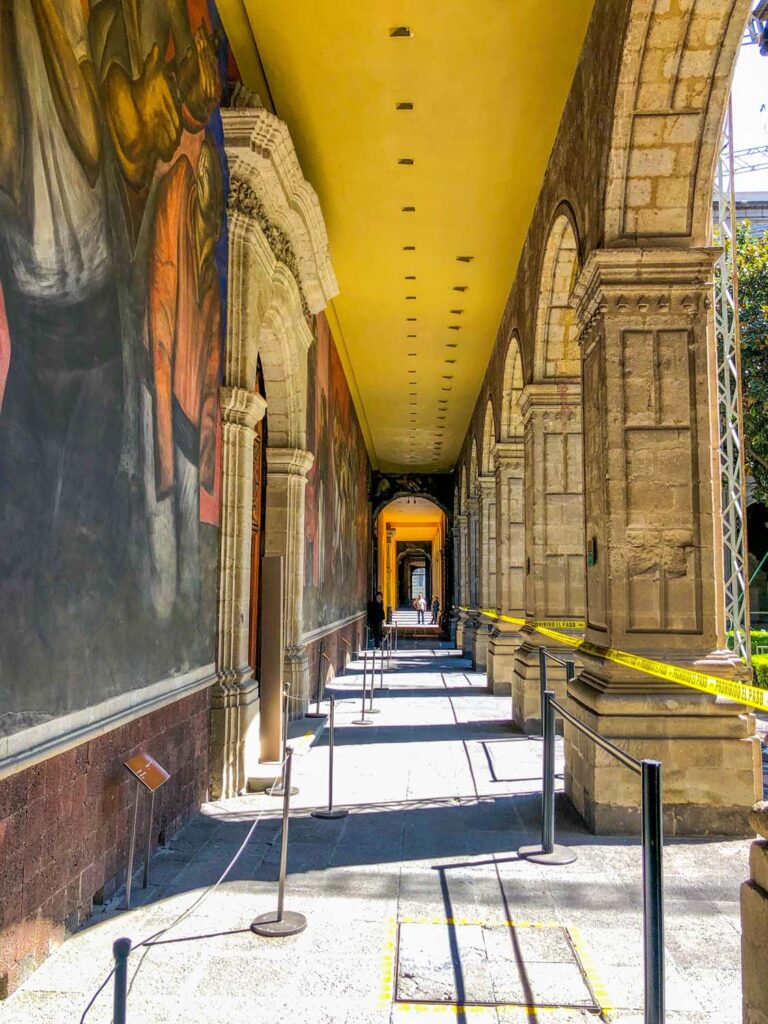
Government Mural Program
As the school was brimming with activity, the government thought this spot would be the perfect spot to feature a new government-sponsored mural. They commissioned a series of murals with themes relating to Mexico’s history and the politics of the post-Revolution era. Various artists contributed to the art spread across the walls of the college. The artists included; Ramón Alva de la Canal, Fermin Revueltas, Fernando Leal, José Clemente Orozco, David Alfaro Siqueiros, and Diego Rivera.
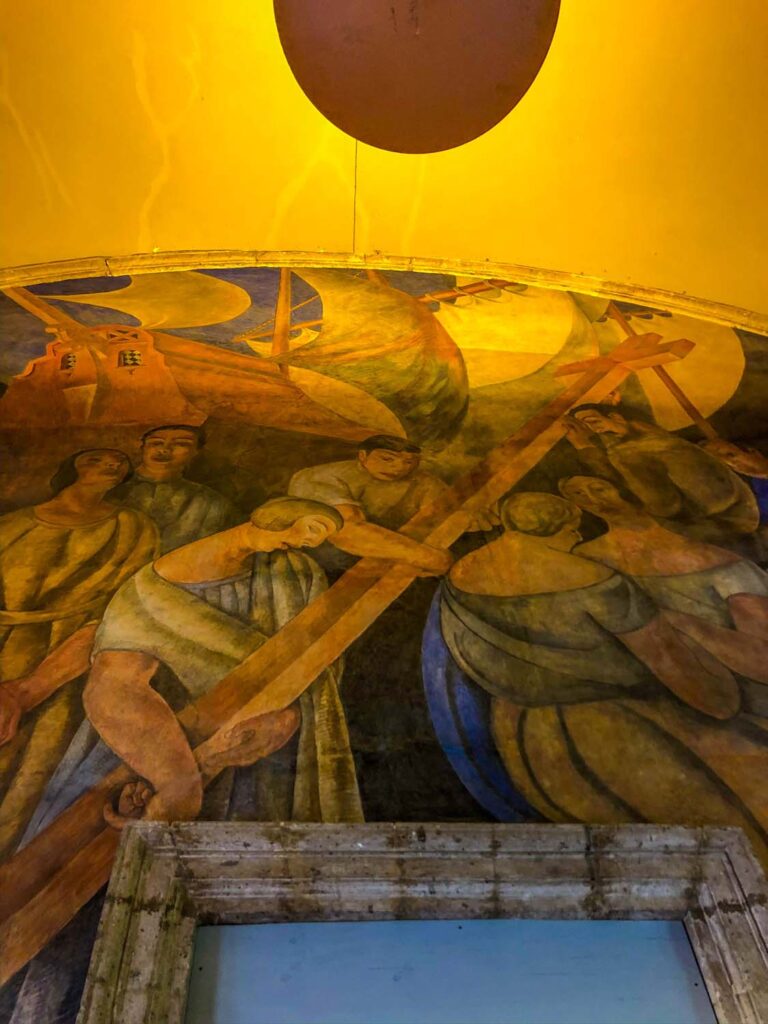
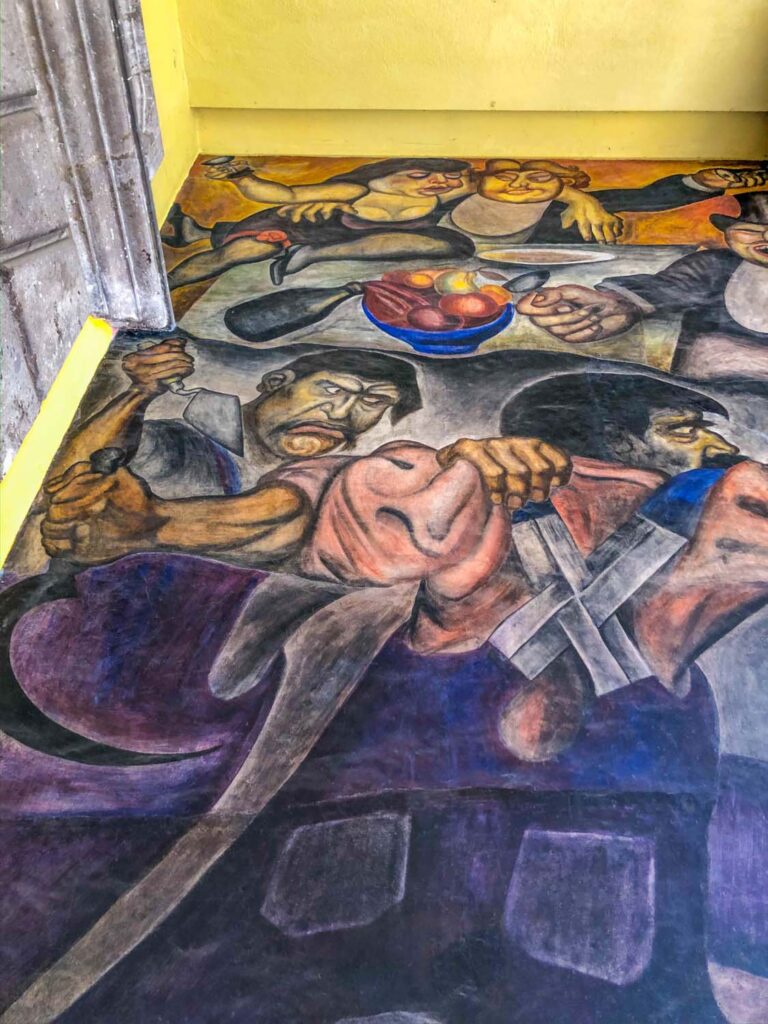
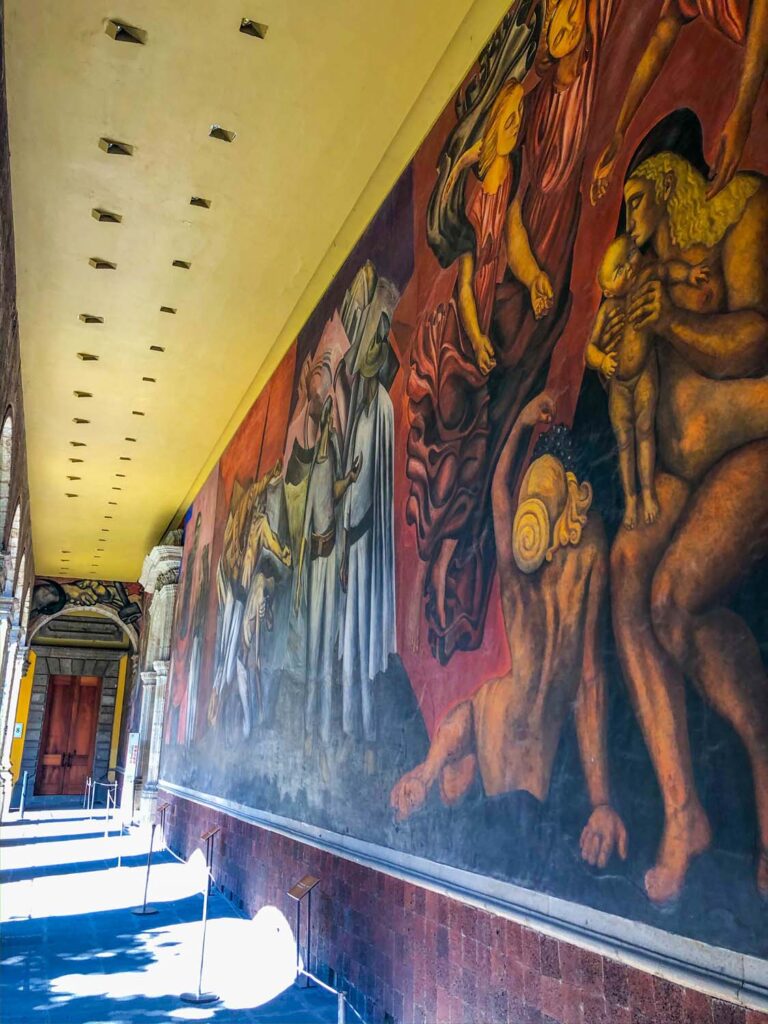
The building remained a functioning college until 1978, when it finally closed its door. It wasn’t until 1992 that it was reopened as a public museum and cultural center. Today there is always a series of rotating exhibitions on display. Many of them feature subjects relating to art and archeology in Mexico.
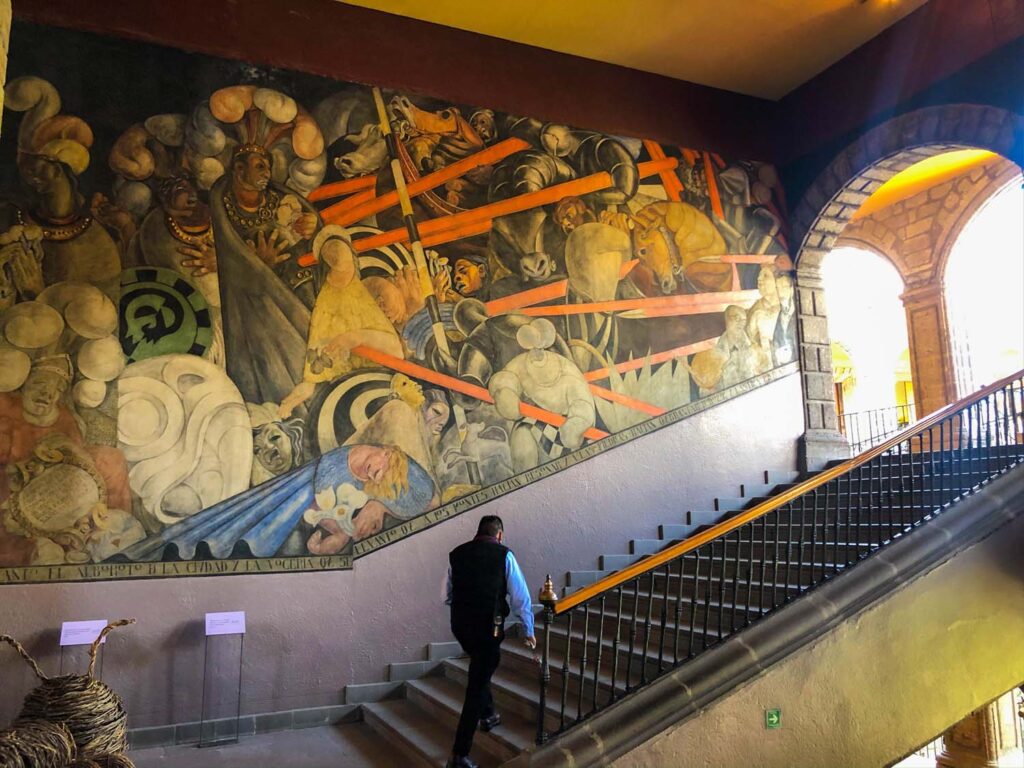
Creation Mural
Admission into the museum costs 50 pesos as there are rotating exhibitions on display inside. But if you just want a peek at Rivera’s work, you can sneak inside the Bolívar Amphitheater. This is found to the left of the entrance. You can access the theatre without admission, so long as there is no performance inside. Inside the Bolívar Amphitheater is one of Diego Rivera’s earliest murals, The Creation. This singular mural took Rivera over a year to complete, spanning over a thousand square feet!
The entire piece is a symbolic composition combining mythological and religious motifs. Along the top, in the center of the mural, is a blue astrological sphere with three hands emanating. This represents the holy trinity, stretching outwards towards the audience. In the middle are images of Adam and Eve, flanked on either side by the muses; Love, Hope, Faith, Prudence, Justice, Strength, Wisdom and Science.
Rivera’s Early Style
In this painting, Rivera’s art style’s youth can be studied. His iconic, more abstract technique seems to be missing. As if he hasn’t found his authentic voice just yet. The piece follows a similar style to that of Italian Renaissance fresco paintings. But even within this early work, his use of geometric structure, powerful facial expressions and strong composition are persistent.
Mercado Presidente Abelardo L. Rodriguez
Less than ten minutes from the college, you can make your way to the Mercado Presidente Abelardo L. Rodriguez. This simple community marketplace is home to a series of murals painted by Diego Rivera’s students. While the work wasn’t by Diego himself, I love the idea of seeing his ideologies passed down to the next generation. And studying the works allows you to appreciate Rivera’s impact on future artists.
Market Murals
The market was built in 1934, and at the time, it was known for being very modern. It spread over 12,450 square metres and featured a daycare, youth center, library and large auditorium. It was more than just a market; it was a community centre. But most importantly, the architect hired Diego Rivera’s students to paint murals. These murals would span the entire interior wall and ceiling with themes portraying socialist ideologies popular at the time in Mexico City.
The young artists were passionate about reflecting the exploitation of workers, peasants and miners, especially by the elite of Mexico. The murals also depicted the fight against the Nazis, fascism, and racism. When the murals were initially painted, they were thought to be the city’s fourth most important public murals. And yet, over the years, they began to deteriorate. After the devastating 1985 earthquake, the marketplace began to fall into disrepair. The humidity started to peel the paint, and as the area was losing its prominent status, vandalism was also a problem. The mural was all but lost to the ages. But thanks to a group of concerned merchants, restorations began in 2008. This ensured these pieces of national history would be preserved. Although restorations are ongoing, you can walk around the marketplace today to see many iconic paintings.
Antigua Academia de San Carlos
Walk south down Calle Loreto, east across República de Guatemala and down La Academie. Here you’ll find the Academia de San Carlos. This was the first art academy in Mexico and the “new world.” They opened their doors in 1785 and primarily taught academic neoclassicism to their students.
But over the years, the students began to rebel against the learnings of teachers from Europe. They longed for their own national artistic identity. This came to a head in 1911 when the student began to strike. This strike would last over two years. The students demanded to be able to paint outdoors. They wanted to be able to experiment more in their artwork and eventually shift towards a modern form of painting. Diego Rivera was the leader they needed and became the academy director in 1929. He was the perfect choice to appease the students. His entire career has been about telling the story of the Mexican people and bringing modern art to the masses.
Palacio Nacional
To finish off our tour of Diego Rivera’s murals in the historic centre, we must pay a visit to the Palacio Nacional (or National Palace). This is his piece-de-resistance. The Palacio Nacional is an enormous museum with so much to see and do. Entrance to the National Palace is free, although there is usually a long lineup to get inside. You need to leave a piece of ID with the guards at the door. Since the Palace is still home to the offices of the Mexican President, security is critical. They need to control the number of people and keep track of exactly who is inside. The entrance to the National Palace can be found on Moneda Street.
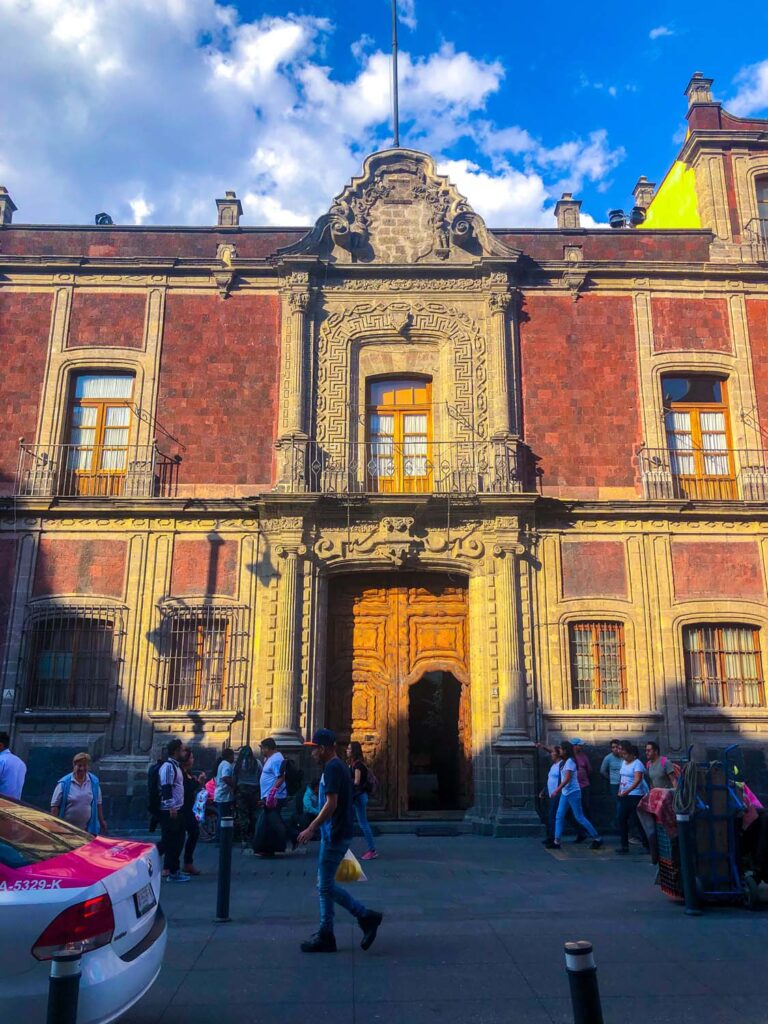
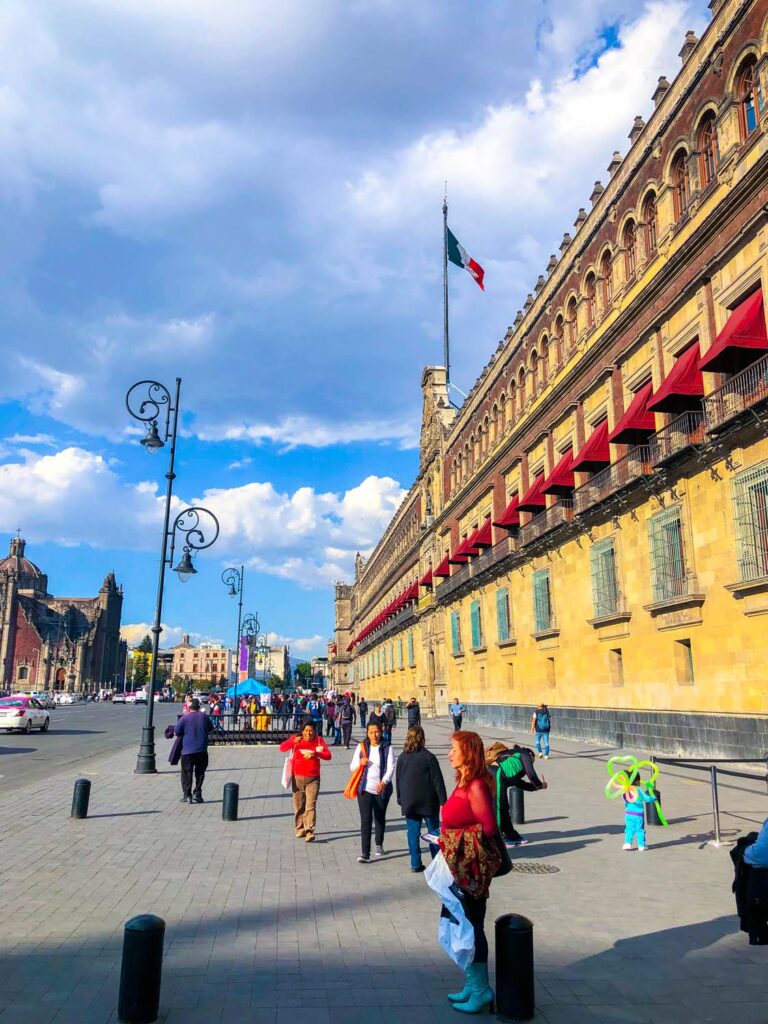
History of the Palace
The site of the building was once Moctezuma II’s Grand Palace. His great residence was built here in 1521. When Cortés first visited the Palace, he described it as having a surprising array of riches. The walls were made of marble, and the facade contained a carved shield of Mexico’s iconic eagle. With the snake in its claws. The building was modern, with sanitary facilities, fountains, gardens, and bedrooms with rich rabbit fur and feathers tapestries. In addition to being a royal residence for the rulers of the Aztec city, it was also a meeting place for the older tribe members. Here disputes and discussions would take place to ensure the wealth and happiness of their people.
Hernan Cortés
Sadly, after the invasion by the Spanish, Hernan Cortés seized the residence from the Aztecs. Cortés was so enamoured by the palace that he used it as his home. Passing it down to his son in later years. The Palace’s devastating fire in 1692 destroyed much of the original structure. Many of the original stones that could be recovered were used in the reconstruction efforts. However, the new palace was styled in the Baroque fashion of the time. It seemed that over time, every generation added its own touch to the building. And now, it looks more like a patchwork quilt of architectural ages.
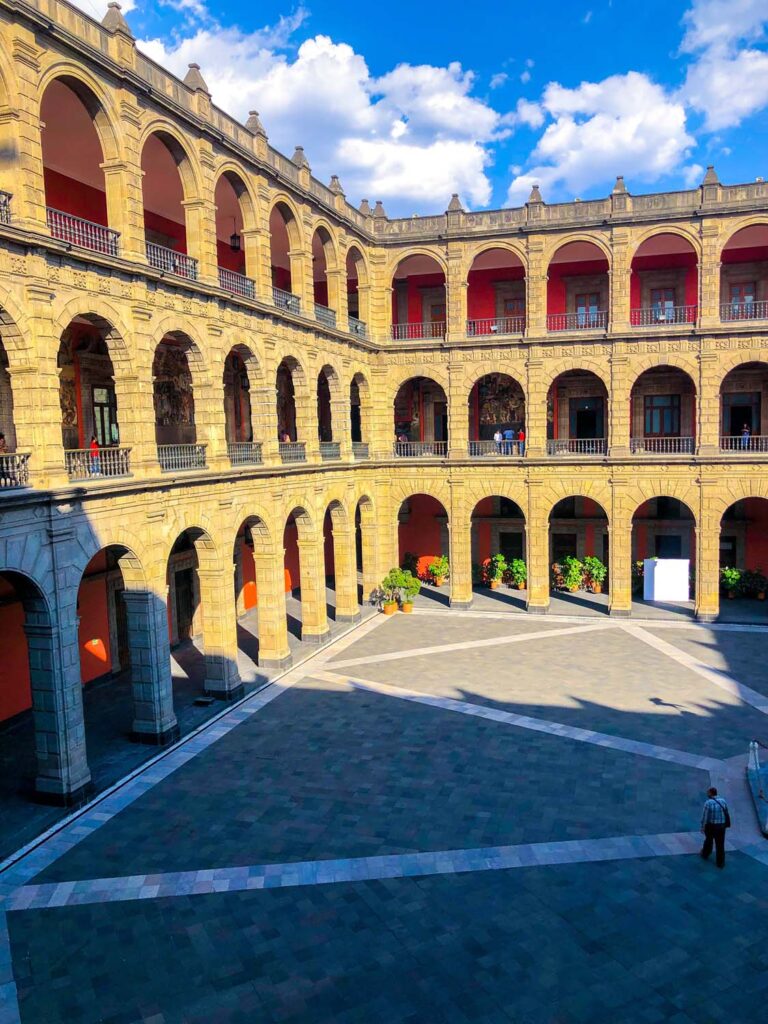
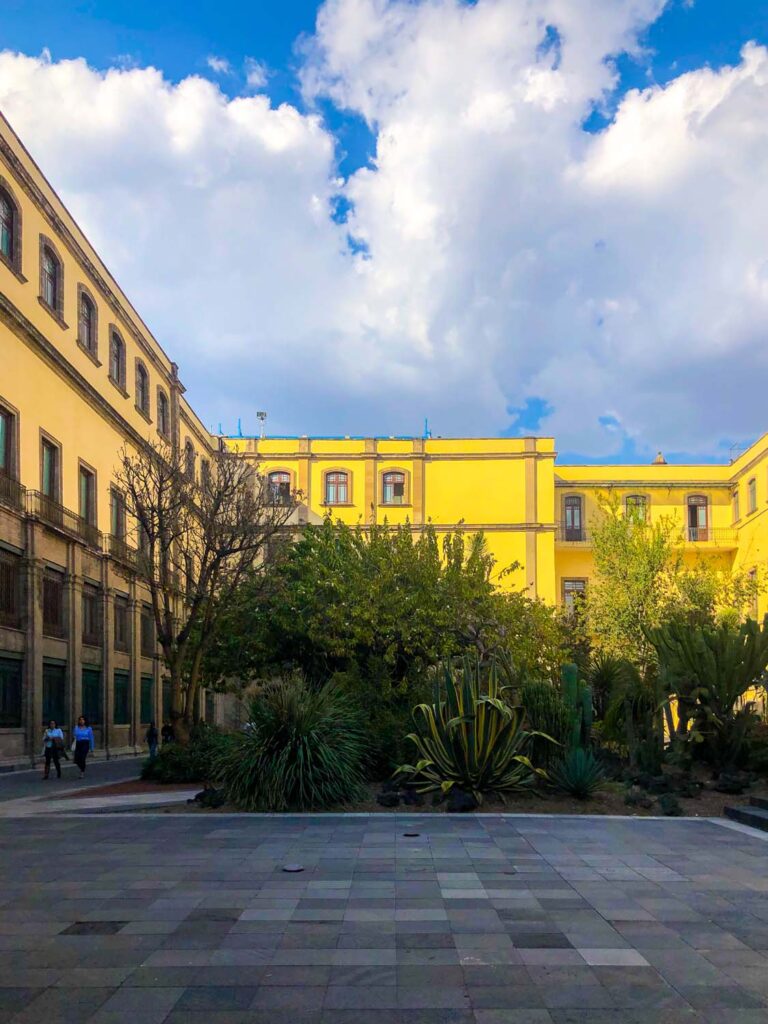
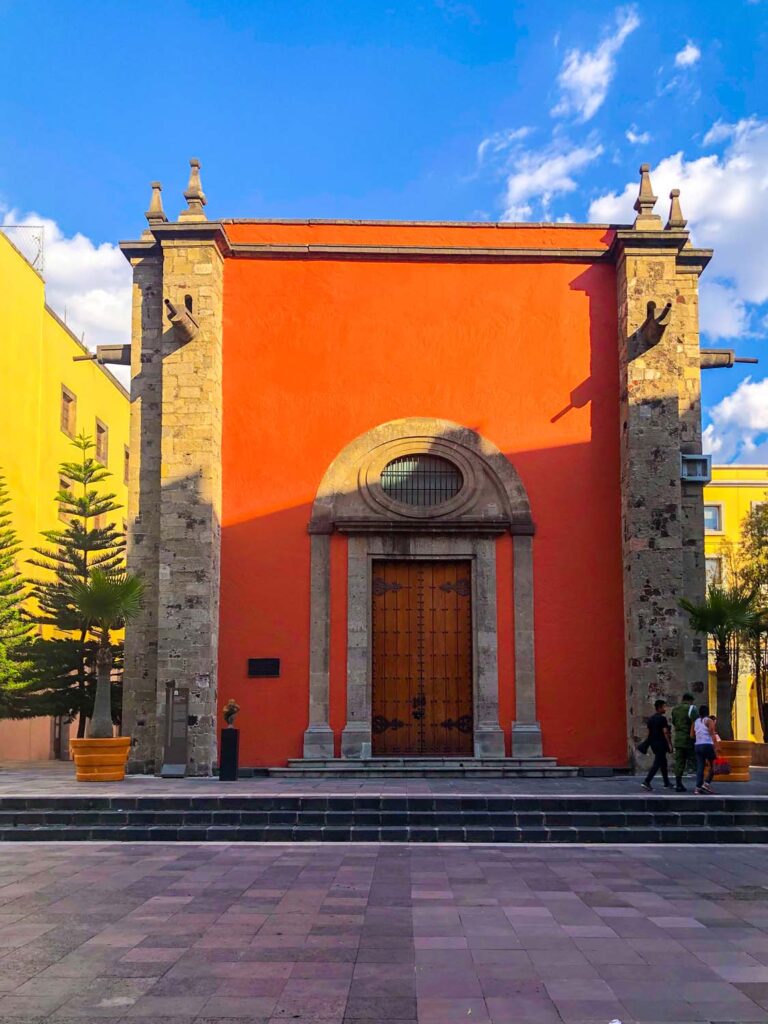
History of Mexico Mural
Walking inside the National Palace, follow the signs for the ‘History of Mexico Murals.’ These can be found within the great courtyard, surrounded by Baroque arches. Walk up to the main stairwell, where you’ll immediately be struck by this immense masterpiece. The mural depicts the history of Mexico from the dawn of human existence through to the 1920s. Rivera started work on this mural in 1929, many years after his first mural project. The precision and confidence in his technical skills and expressive style are evident in this work of art. Rivera was decisive in using his art to communicate his ideologies about communism and the rejection of the colonizers. He wanted to bring the crimes of the past clearly into the minds of the people. To ensure these atrocities were never forgotten.
The main message of the mural surrounds the indigenous Mexican people’s struggles to preserve their culture, National identity and country against the brutal colonizers. Standing at the base of the stairwell, take a minute to appreciate the sheer grandeur of the entire piece. So much of the story is sad—a classic tale of good vs. evil. The goodly indigenous Mexicans had one of the most vibrant cultures. Yet, they were practically wiped out by the evil, invading Europeans.
If you squint and look at the entire piece, the bright colours and expressive shapes look powerful, hopeful and strong, just like the Mexican people. Despite the horrors of the past, the post-revolution population believed in the future of their country. Especially as it became an independent nation. And that their strength and perseverance would conquer evil and allow their great country to prosper.
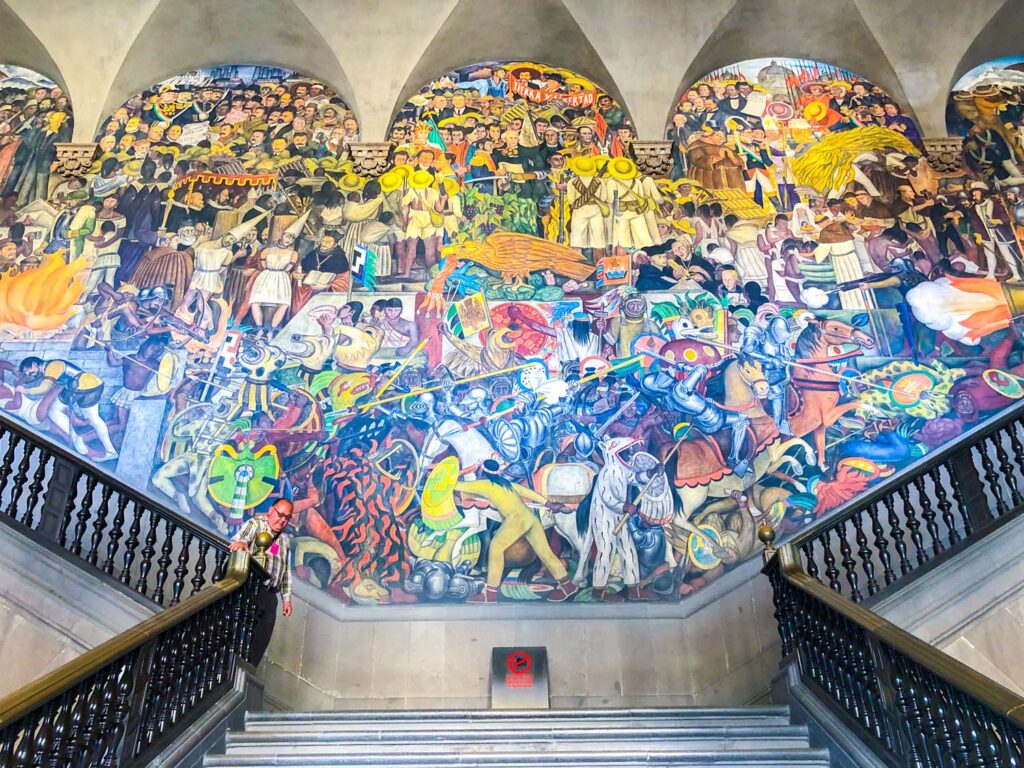
North Wall
Walk up the stairs to the landing in the center, and look up at the left side, or North Wall. This part of the mural depicts the indigenous Mexicans long before the arrival of the Spaniards. They are surrounded by the fantastical Mexican landscape all around them. The blue is almost heavenly —the large bright sunshine above casting all of them in celestial light. The Aztecs believed in the sun god, as seen in the all-seeing eyes painted onto the sun’s face. Just below the sun, you can also see an erupting volcano with Xiuhtecuhtli’s “the Lord of Fire” exploding from the mouth of the volcano. In the sky flies Quetzalcoatl, the Feathered Serpent deity and god of the wind and the rain.
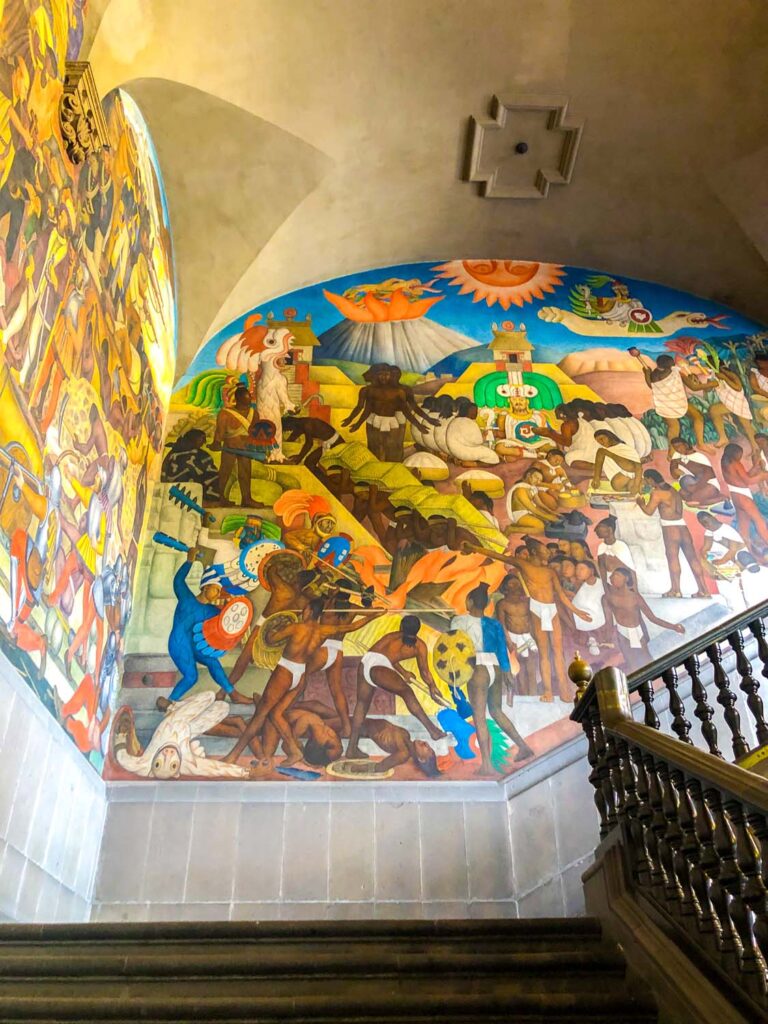
The Valley of Mexico is spread along the horizon, with its amazing pyramids towering above the people. Standing in front of the pyramids are the Aztec leaders, guiding and looking after their citizens. In the left corner, you can see a small battle scene between two tribes. This violence was a common occurrence in any civilization. But the cultural costumes worn by the different tribes make this little vignette so interesting.
Farmers are tending to vivid corn crops, almost as bright as gold. Craftspeople in the lower right-hand side of the mural are busy weaving, making pottery, playing music, painting and writing on scrolls. This shows their modern civilization, full of technology, art and science! They were the farthest thing from “savages,” as the violent Spanish colonizers reported.
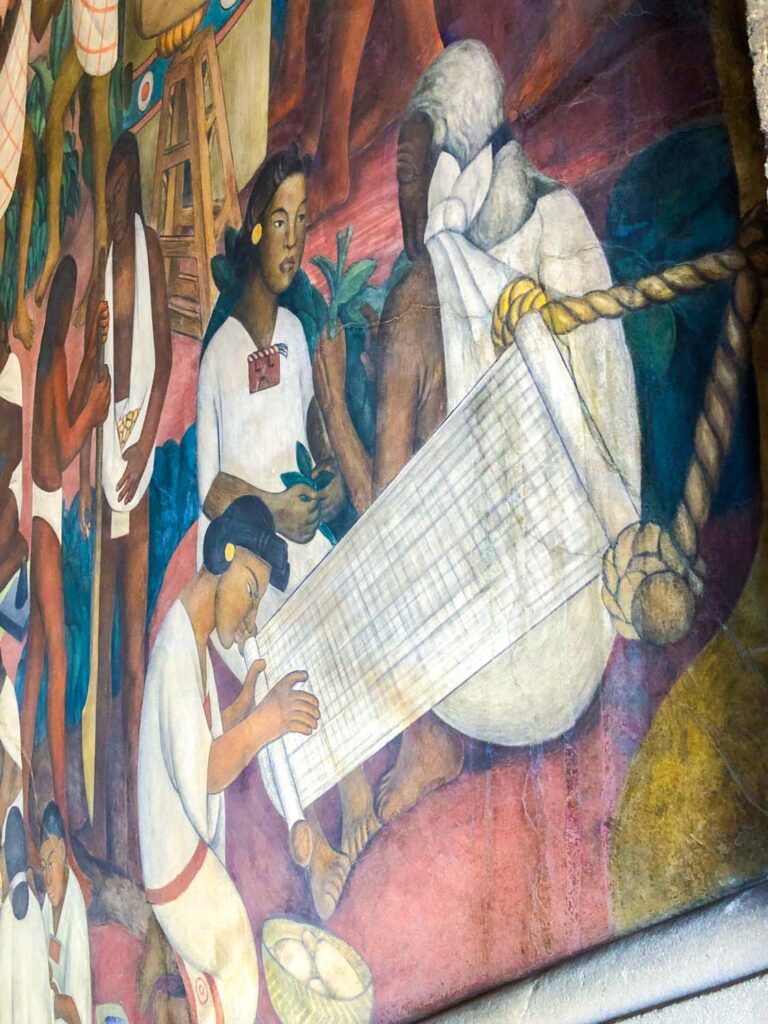
West Side, Main Wall
We move from the north wall’s idyllic memories to the densely packed and violent images of the west wall. This is the mural straight ahead as you walk up the main stairs. It is the battle of the Mexican people against their oppressors. A story of hatred and war is woven into the fabric of Mexico’s history.
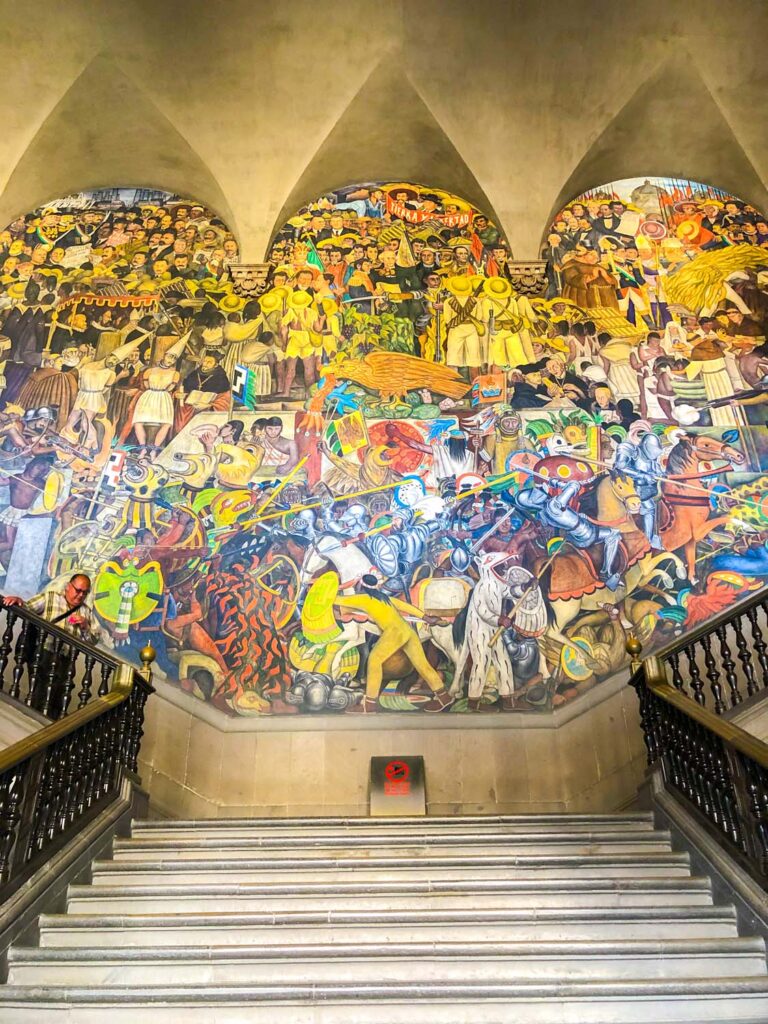
Lower Level Depictions
The lower part of the mural is riddled with images of Mexicans and Indians fighting against the heavily armoured Spanish and French cavalry. The beautiful and bright feathered costumes of the Aztec leaders crushed and fell under the feet of their enemies. Cortez can be seen in the middle of the painting, as he is the only mounted soldier with his face exposed. The rest of the attacker’s helmets are closed. But Rivera paints Cortez with his helmet raised, so his actions are not anonymous.
Cortez’s armies have modern weaponry making their defeat of the Aztecs a foregone conclusion. Despite being outgunned and outnumbered, the Aztecs fought valiantly against the Spanish on the right and left corners. All the while, the Aztecs are being watched over by a great golden eagle in the center. The eagle sits perched atop a cactus with a serpent in its mouth. The design of this symbol is rooted in the legend that the Aztec people would build their great city on the spot where they found an eagle eating a snake on top of a cactus. They called that place Tenochtitlan (Mexico City), and it was worth fighting for them.
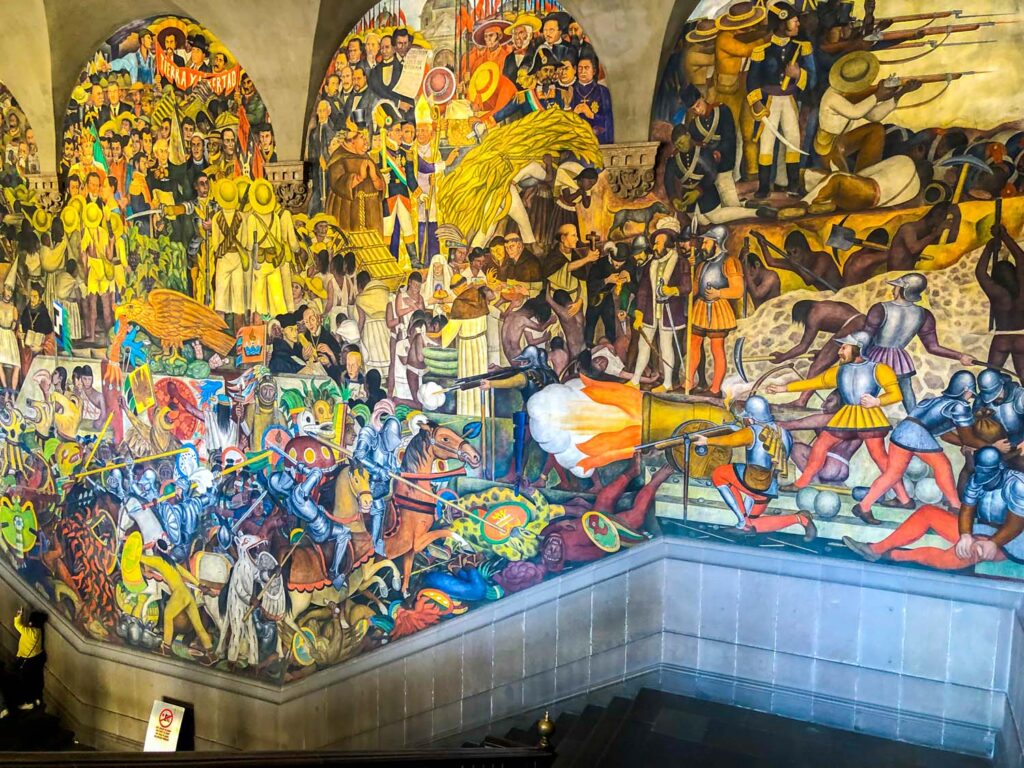
Middle Depictions
In the middle of the mural, we see the horrors brought to Mexico by the Spaniards. Not only did they want to conquer the land, but they also wanted to abolish the Aztec religion. The Inquisition went about burning sacred books and religious imagery. You can see these fires burst out across the wall. Priests on the left-hand side can be seen forcefully converting the indigenous people to their new religion of Chrsitiniarity. The Spanish turned many natives into slaves, and these hard-working people were the creators of this “new world.”
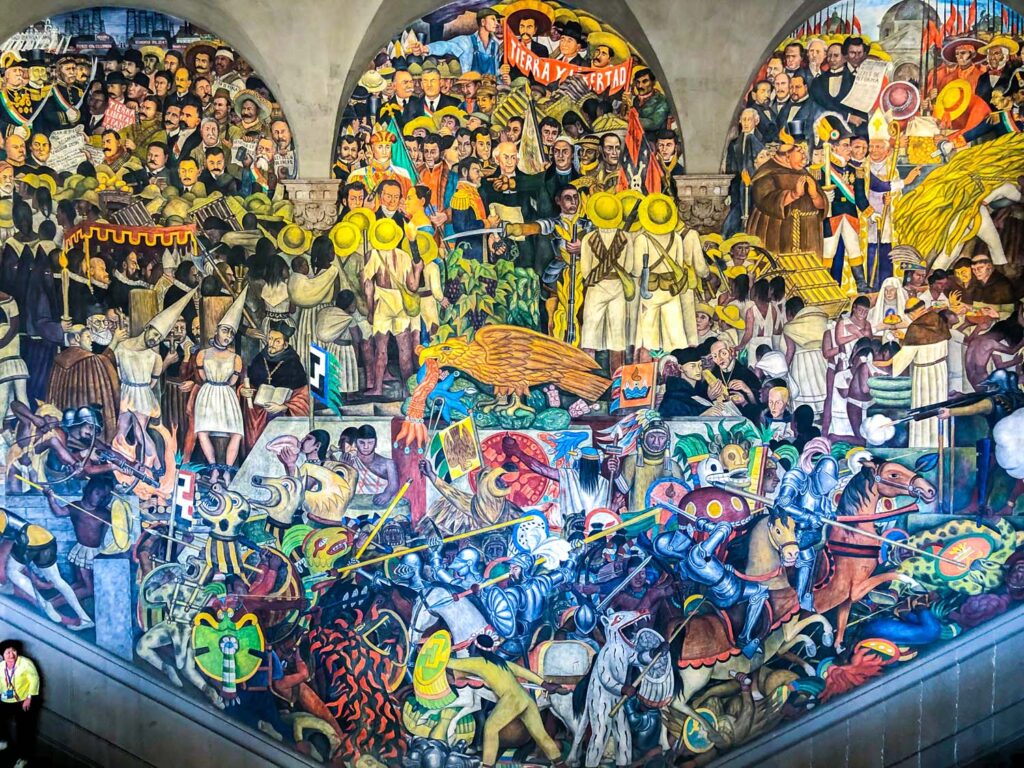
Upper Arch Depictions
Under the five arches at the top of the wall are the various rulers of Mexico. Interesting to note is Rivera’s use of non-hierarchical representation. No one man is larger than the other. While some think it makes the mural more challenging to interpret or read, it is part of Rivera’s communist ideologies of equality.
Starting from the left, we see the French Rule and execution of Austrian Emperor Maximilian in 1867. Next to that, we see images of the Porfirian era. This era was coloured with a brutal dictatorial rule accomplished through consensus and repression. In the central arch, we see depictions of Independence and the Mexican Revolution. You can see a man with a mustache carrying a large red banner at the very top of the frame. This is revolutionary Emiliano Zapata, who was one of the leading men in the revolution. The red flag says “Tierra y Libertad,” which means “Land and Liberty.”
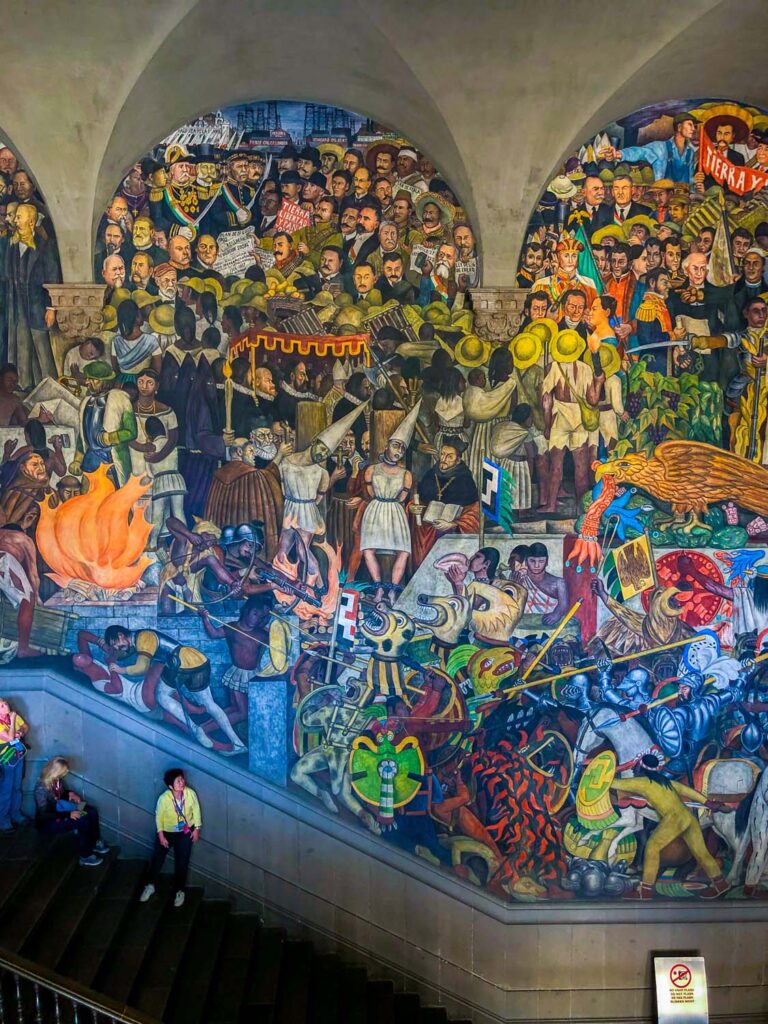
To the right, we see images from the Reform and Juarez eras. Benito Juarez was Mexico’s only Indigenous president and the founder of the new Mexican nation. Finally, on the far right, we have the invasion of Mexico by the US. Above the invading US army is the great eagle flying down to attack.

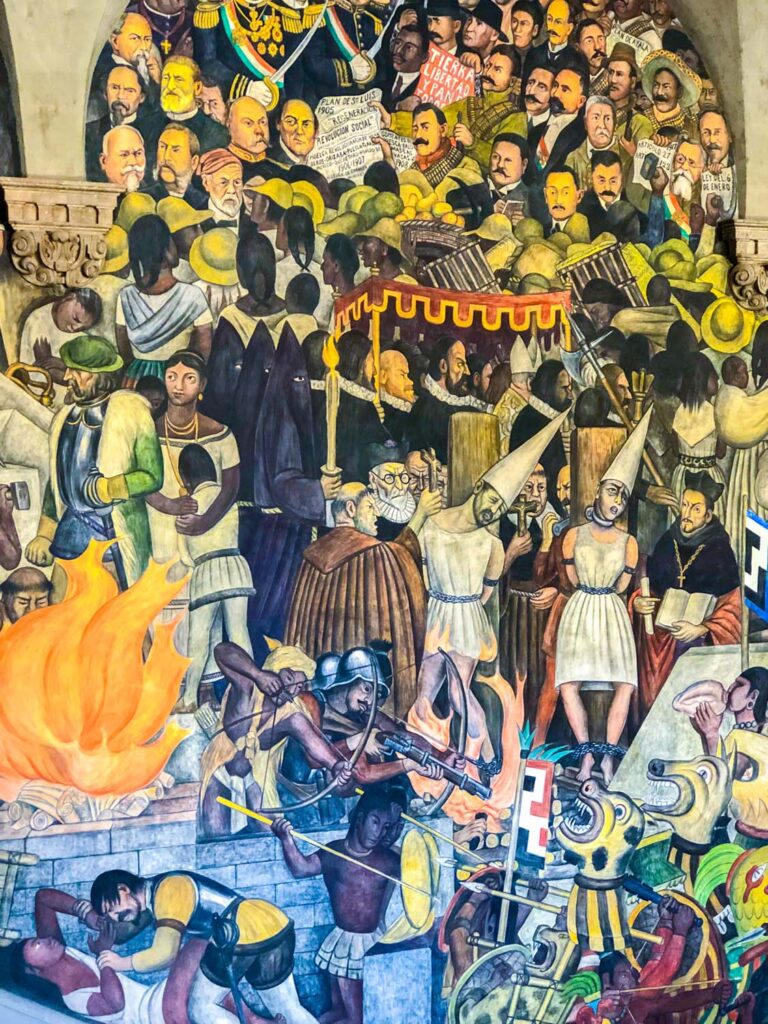
South Wall
The south wall to the left of the main stairwell depicts the future of the Mexican people. The imagery represents progress, prosperity and hopes for a better future. At the top of the mural is the image of Karl Marx holding his great Communist Manifesto on a large scroll. To the right of this is a man flying the Soviet flag. When the mural was painted, the Mexican people and Rivera himself had solid socialist tendencies. The Soviet flag can be seen throughout imagery from this era.
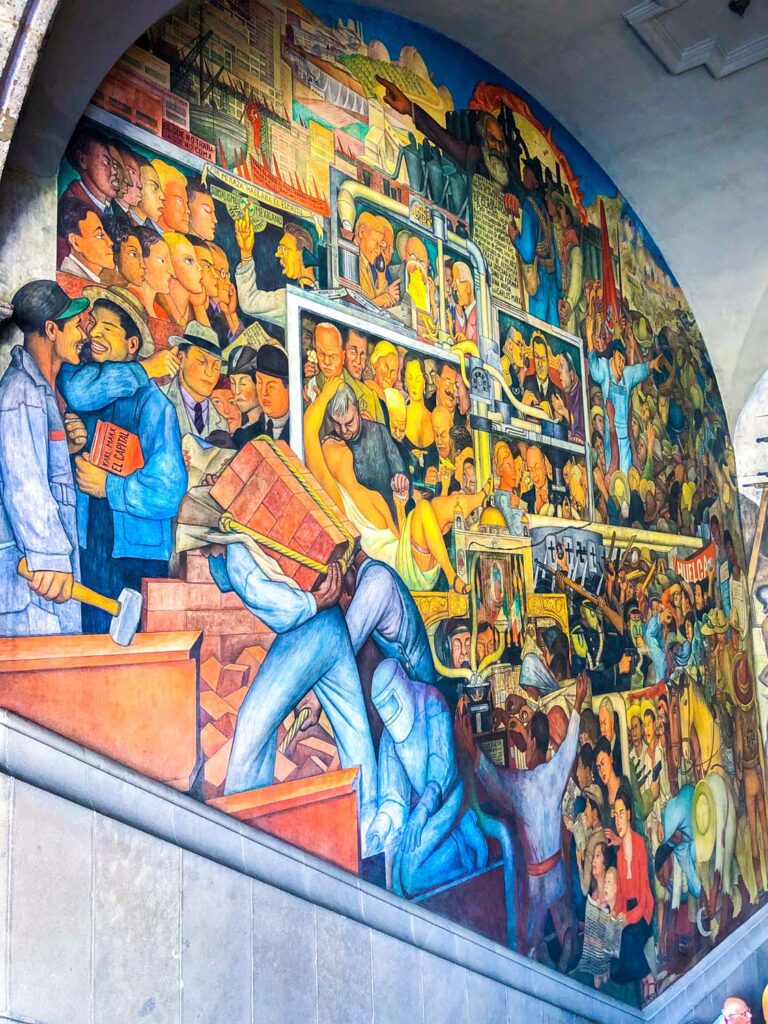
To the right of Karl is a scene of Mexican workers. They are being attacked and oppressed by police wearing large gas masks. This scene takes place in front of Mexico City’s skyline silhouette. While the other two murals are more fluid in their collage-like design, this mural is framed in harsh geometric metal beams. Inside these almost cage-looking rectangles are pictorial representations of what Rivera saw as negative social forces in high society.
At the bottom of the painting is the image of a woman dressed in bright red. Look closely at her face to see if you can recognize the model. It is none other than his wife, Frida Kahlo. Frida holds a copy of the Marxist manifesto and is engaged in a political rally. Very similar to her real-life political activism. Above her is another similar-looking woman. This is Frida’s sister Cristina, with whom Rivera had an affair during his marriage to Frida.
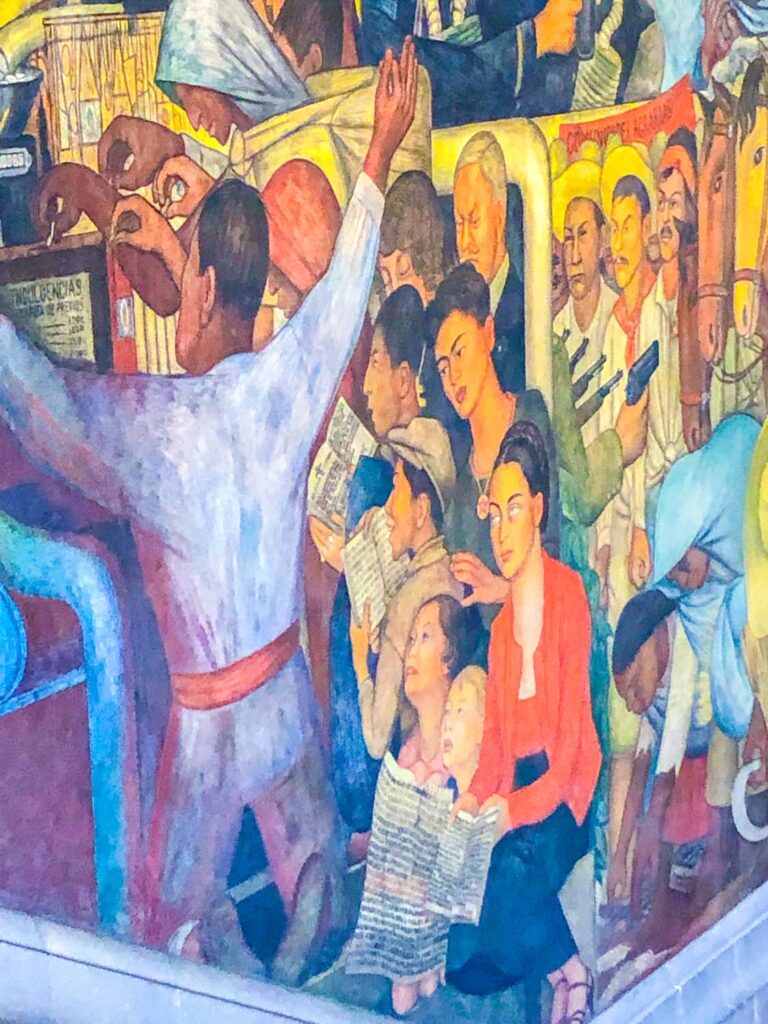
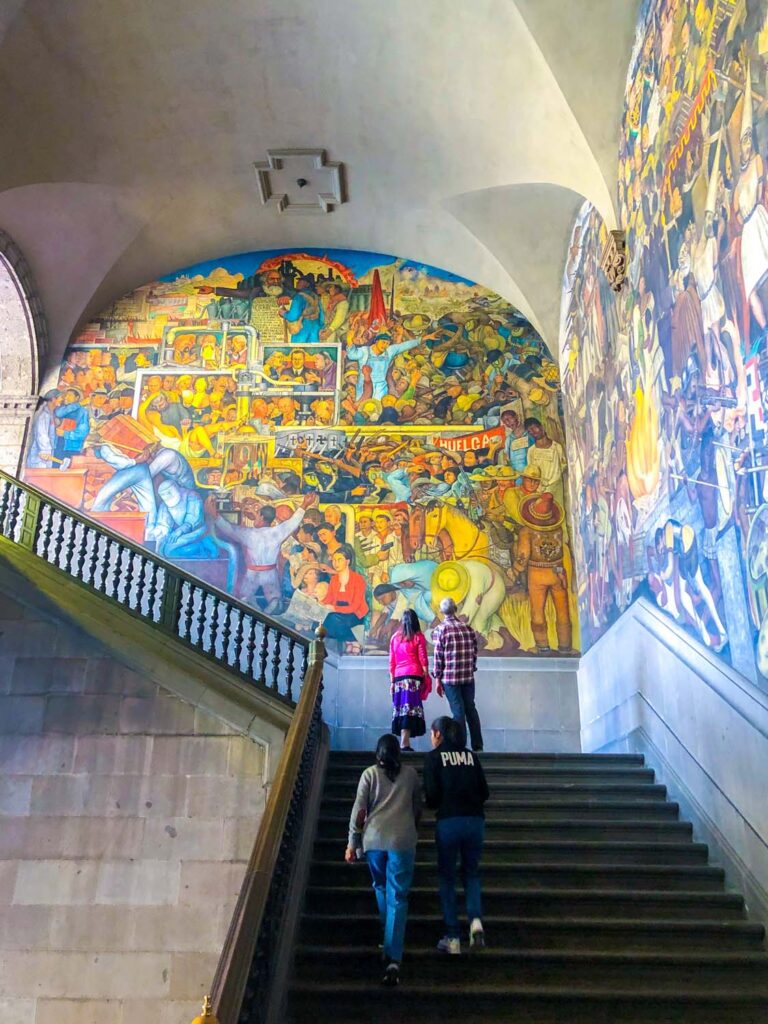
Second Level
On the second level of the courtyard patio are 11 additional murals painted by Rivera. These are continuations of the history but highlight particular scenes that Rivera found to be important during the pre-Hispanic era. These murals were not finished, and it’s interesting to see them as works in progress captured in time.
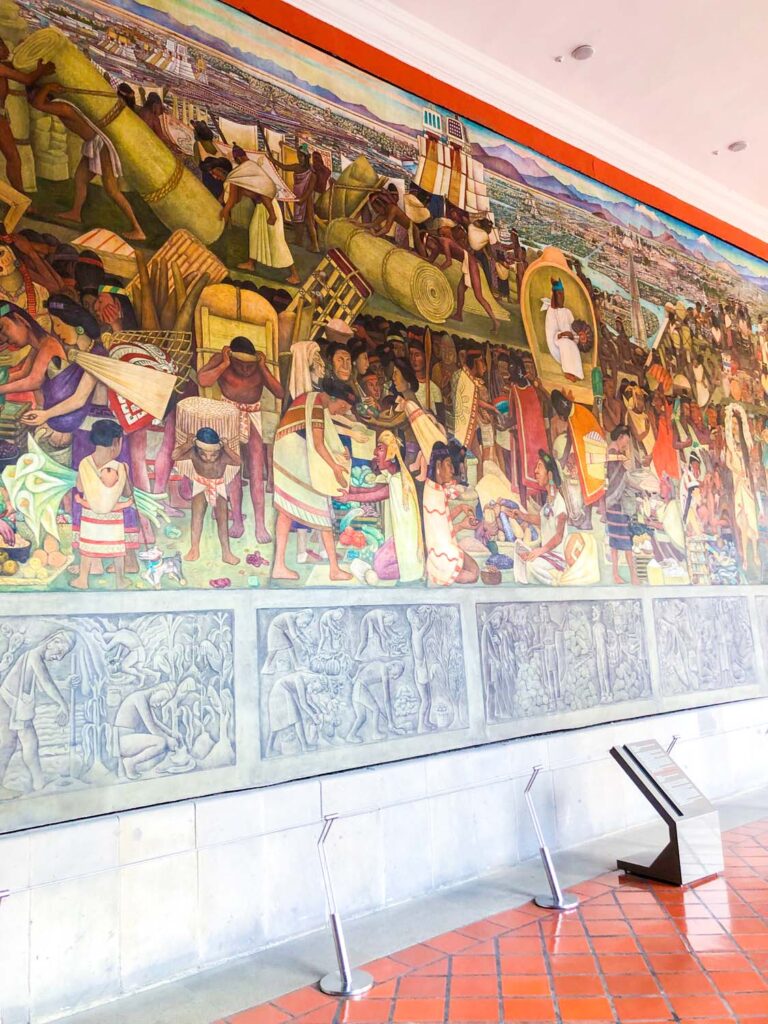
Cárcamo de Dolores
There are several other spots in Mexico City to see if you are following in the footsteps of Diego Rivera. One location to visit that is home to two important spots is the great Bosque de Chapultepec or Chapultepec Park. The park is one of the largest city parks in the Western Hemisphere and spans over 1,600 acres! A dense and populated city needs fresh air, and this park acts as its “lungs,” with trees that replenish oxygen to the Valley of Mexico. The name Chapultepec stems from the Nahuatl word chapoltepēc, which means “at the grasshopper’s hill.” If you find yourself in Chapultepec Park, you can also visit the Cárcamo de Dolores.
The Cárcamo was built in 1951 under engineers Eduardo Molina Arévalo and Guillermo Torres. The Cárcamo de Dolores (or Sump of Dolores) was a hydraulic structure that housed a giant water tank. From here, the city would control the levels in several other large water reservoirs. But, the space was given an artistic flair by Diego Rivera.
Tláloc, the God of Water
Once the new system was implemented, they set about creating this museum in honour of the water god Tláloc. Tláloc is the god of rain, water and earthly fertility. Walking up to the building, you can see the giant tiled fountain with the image of Tláloc lying down, spread over 100 feet wide. He lies with his legs laid splayed, decorated with brightly coloured stones mined from the natural resources of the Mexican landscape. Originally, the area where we now find the fountain was the entry point where the Lerma River water entered the city’s reservoir.
Water has long been both worshipped and yet highly problematic in Mexico City. After the Spanish conquest, they drained the precious life-giving rivers and lakes. Since then, the city has constantly been searching for accessible water. So people are continually making their prayers to Tláloc. In the hopes he can solve what even modern-day engineers still have not.
Main Building
Inside the main building is where you can find Rivera’s murals, Water, Origin of Life. These murals pay tribute to the workers, engineers and architects who participated in the construction of the original Cárcamo water system. These 200 square meters of murals were meant to be underwater, making them the only underwater mural in the world. Today, the murals’ pools are empty, allowing the public to observe the artworks. Constant aquatic exposure resulted in the slow deterioration of these historical works, so the water was drained and diverted. A pipe organ has been installed to give the room the same atmosphere as it once had. The organ makes noises through the adjacent municipal pipes to make the room sound like a functional waterway.
Panteón de Dolores
On the other side of the Avenue Bosques in Chapultepec Park is the great Panteón Civil de Dolores. This Pantheon, or cemetery, is the largest cemetery in Mexico. And in my opinion, this cemetery is one of the greatest in the world! Filled with some of the most incredibly elaborate and imaginative tombstones. The cemetery was built in 1897 on Juan Manuel Benfield’s ranch. Benfield founded the cemetery in honour of his wife, who had recently died in Veracruz. She couldn’t be buried in Veracruz as all cemeteries there were for Roman Catholics only, and they were practicing Anglicans. The cemetery grew and grew over the years, becoming home to some of the most illustrious dead of Mexico City. Today, the cemetery has over 700,000 tombs and is considered the most crowded cemetery in Latin America.
They even have a special section of the cemetery called the ‘Rotonda de las Personas Ilustres‘ (Rotunda of Illustrious Persons). This area honours those who have exalted Mexico’s civic, national and human values. Originally it was named the Rotunda of Illustrious Men. But it was renamed by President Vicente Fox in 2003 as the cemetery also honours many famous women. The first person to be buried here was soldier Pedro Litechipia, who died fighting against the empire of Maximilian in 1876.
Diego Rivera’s Tomb
Included among the illustrious dead is Diego Rivera. Interestingly enough, Rivera had requested that he not be buried at all. Instead, he wanted to be cremated and his ashed comingled with those of his beloved Frida Kahlo. Frida’s urn can be found inside her beloved Casa Azul. Sadly, upon his death, his family overruled his decision and had this tomb designed to house his body. The vault was designed with pre-Hispanic patterns and symbols swirling around the tombstone. Emerging from the stone are the bright white marble arms and the death mask of Diego Rivera himself. As if the artist is merely asleep and is rising from the grave. Haunting and yet beautiful all at once.
The Flower Vendor (Girl with Lilies)
On either side of the tomb are bouquets of white calla lilies carved in marble. So they may bloom for eternity. Rivera’s famous The Flower Vendor (Girl with Lilies) is one of Rivera’s most famous artworks. Although the lily is associated with funerals and death to Rivera, it symbolizes indigenous culture. It also references Mexico’s abundant flora and even a hint of sensuality, as the flower resembles a certain part of the female anatomy. Flower sellers also represent the poor working class. Who sold the beauty of the Mexican landscape to the wealthy upper class, which consumed it. For this reason, focusing on the flowers on his grave is even more important to his legacy.
Tomb Mosaic
Above the tomb, on a large stone marker, is a beautiful mosaic. It features the image of an older indigenous woman surrounded by lit candles. The scene appears dark as if she is here at night. She kneels on the ground, planting seeds with a woven basket in front of her. A symbol of how Rivera planted seeds in the minds and eyes of the Mexican people. Inspiring them for ages to come. On the opposite side of the mosaic is a burst of Rivera set into the stone. Below it is a large inscription dedicated to the life and impact of the great artist.
Coyoacan and San Angel
You can visit many other places that are significant to Diego Rivera, located outside the city centre. Luckily, Uber makes seeing many of these destinations very straightforward. Two neighbouring areas worth visiting are the colourful suburb of Coyoacan and the quiet artistic streets of San Ángel.
Museo Casa Estudio Diego Rivera y Frida Kahlo
The rural hamlet, filled with cobblestone streets and bougainvillea-covered colonial homes of San Angel, was where Diego Rivera called home in his old age. While the Casa Azul was Frida’s palace, the Casa Estudio was Diego Rivera’s oasis. Here, you can learn more about Diego, the man, not just Diego, the artist. This was Rivera’s dream home. He had it custom designed by architect and friend Juan O’Gorman.
Juan O’Gorman
O’ Gorman studied functionalist construction under the swiss design of Le Corbusier. Gorman was enthusiastic about bringing this modernist style to Mexico City. A city he saw as being a hub for modern thinking and exquisite architecture. Diego and Frida’s studio house would be the first construction using functionalist architecture in Latin America. Functionalism was a style defined by buildings that should only express their use or function. They removed excess decoration and prized minimalism.
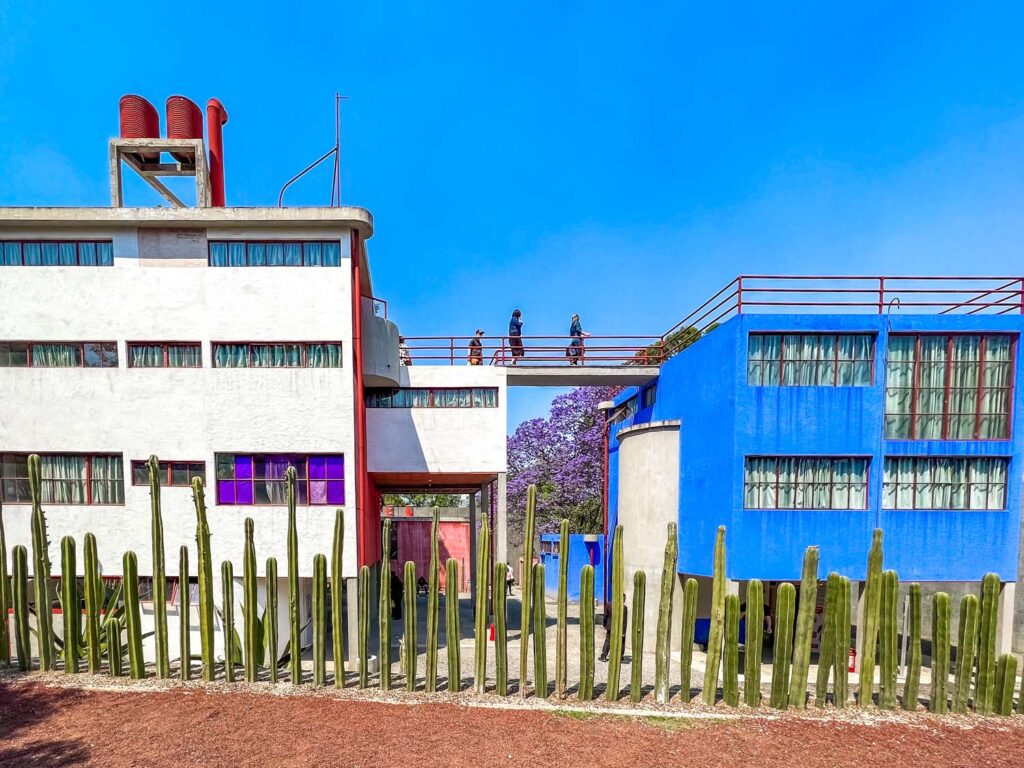
For Diego and Frida, this functionalist ideal represented their need for two separate studios. Functionally, they could not work together. Frida and Diego’s relationship was plagued with intensity, both good and bad. But when it was bad, it was very, very bad. They found the need to have two different spaces to work to focus on their craft without quarrelling with one another all day. And yet, the two buildings are connected by a large bridge on the top. It is a symbol of their love. That at the end of the day, they still found a way to come together and connect.
The Architecture of the House/Studio
The two buildings were designed almost as polar opposites. Diego’s studio building is painted off-white and rust-red. Simple, natural colours. On the other hand, Frida’s studio is painted the same ethereal cobalt blue as her Casa Azul. Both studies feature almost floor-to-ceiling windows, giving the interior space an indoor/outdoor feeling. The houses are separated from the street by a perimeter fence. But instead of being made from wood or wrought iron, the fence is made of rows of tall cacti along the roadside. Giving it the most iconic appearance.
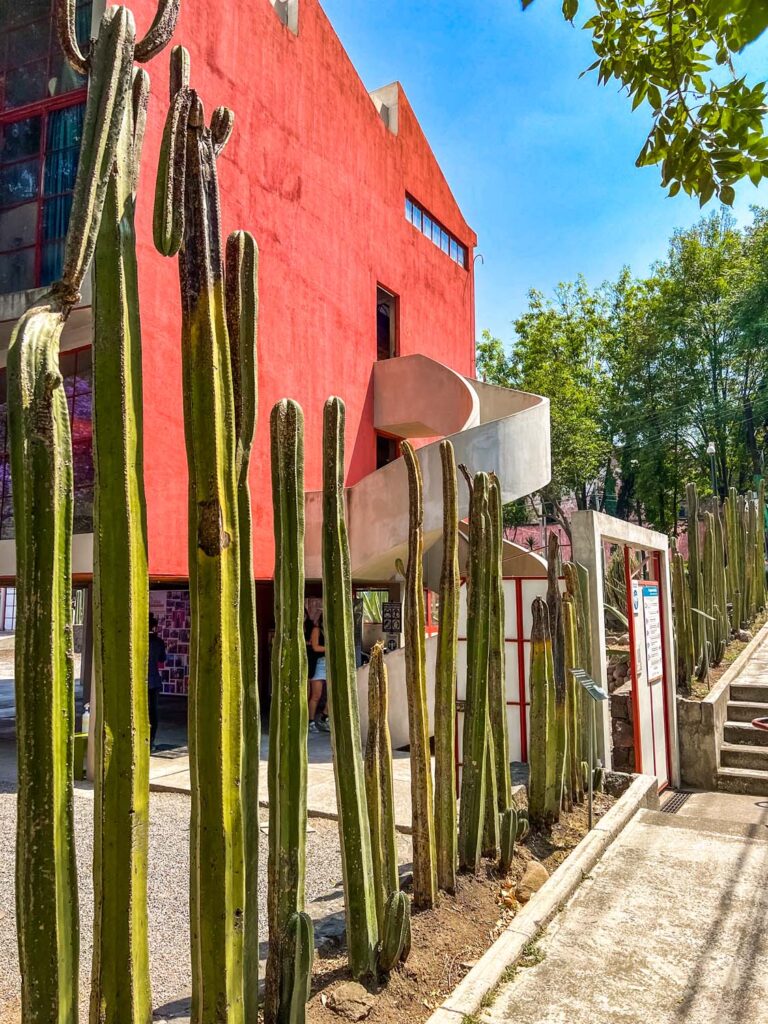
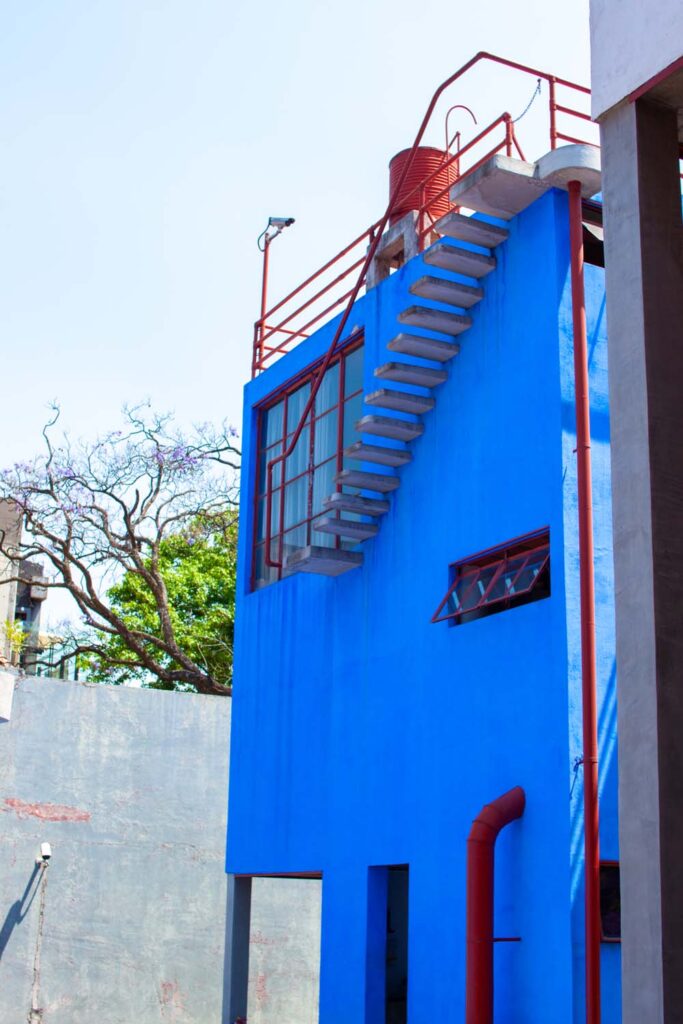
The couple lived here from 1934 to 1939. In 1939, they divorced, and Frida moved home to Casa Azul. Leaving Diego to live full-time, alone in the studio house. After their divorce, the couple actually got back together only 9-months later. But even after this reconciliation, Frida and Diego kept the studio house. Diego would continue to live there full-time until his death on November 24, 1957. Rivera died in his studio, and his body remained there as friends and family sat vigil inside to mourn the loss. After this, his body was moved to the Palacio de Bellas Artes for his state funeral. After his death, his daughter inherited the house. But she gifted it to the Instituto Nacional de Bellas Artes to be enjoyed by the public for years to come as a museum.
Diego’s Studio
Diego’s studio is filled with natural energy. The floor-to-ceiling windows allow sunshine to shine through and ignite the space. The studio museum still contains brushes and pigments, which Rivera used to make his murals. He is sitting on his easel like he is about to walk back into the room mid-painting. Dotting the walls are items from Rivera’s pre-hispanic arts and crafts collections. Books lined the shelves, which served as artistic inspirations and portraits of Diego’s many friends and fellow artists. It really felt like a space that was intimate and highly personal.
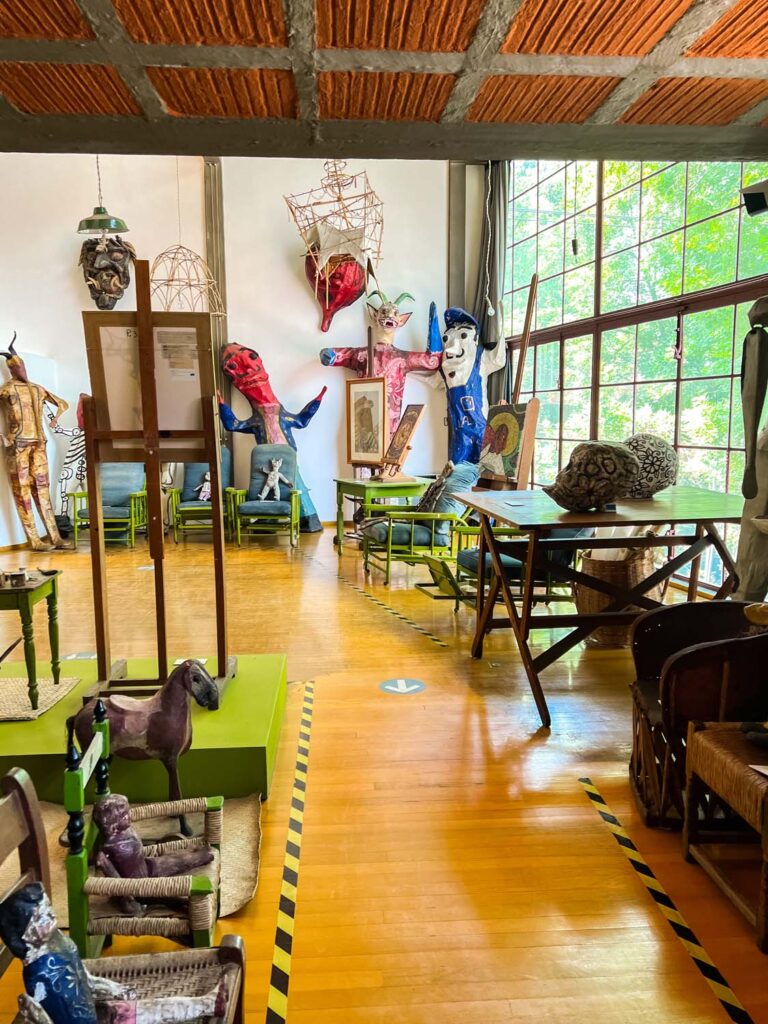
But filling the majority of the studio are these huge paper-mâché figures. These are called “Judases” and are life-sized papier-mâché dolls popular in Mexican folk art. These are usually made to be burnt as a part of the celebrations on the day before Easter. The figures are made in the image of Judas the Traitor or other unfavourable people. This could be anything from images of devils and demons or even politicians, criminals and disliked shopkeepers. They are then stuffed with fireworks and blown up on the street. Much to the enjoyment of the onlookers. But Rivera didn’t blow them up. Instead, he kept them as souvenirs of the local artisans. Although the simple craftsmen who made them might not see them as high art, Diego saw these as treasures to keep forever.
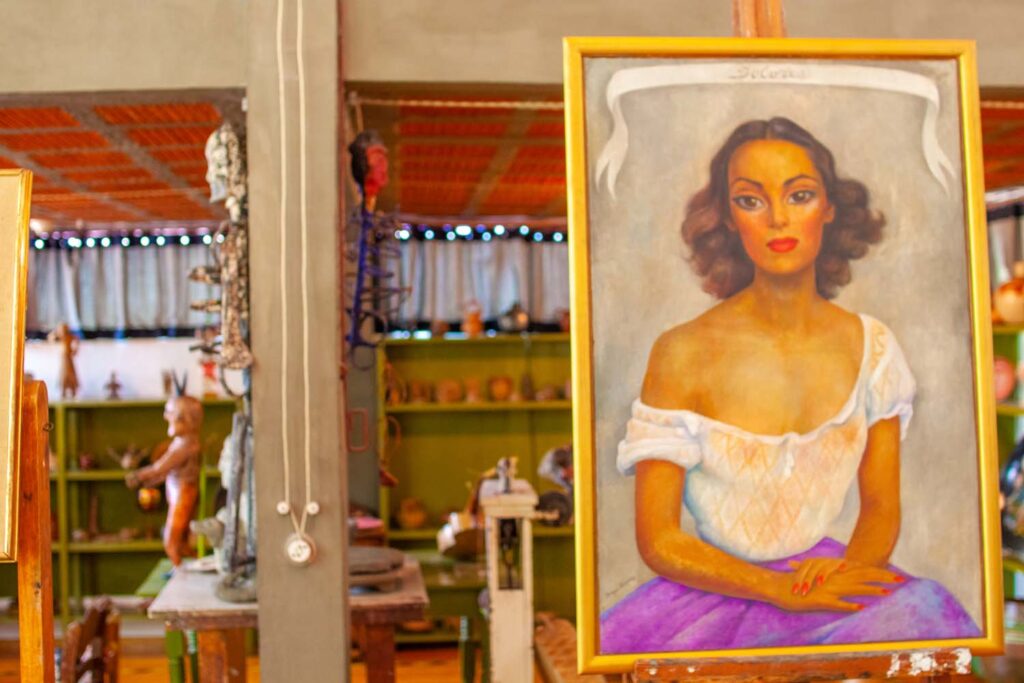
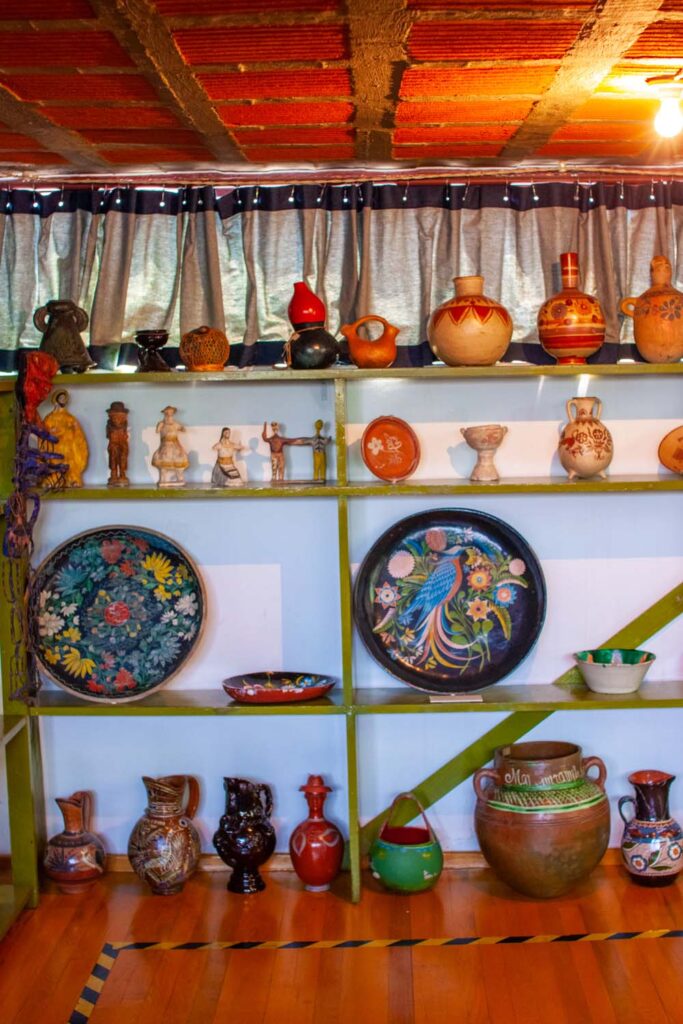
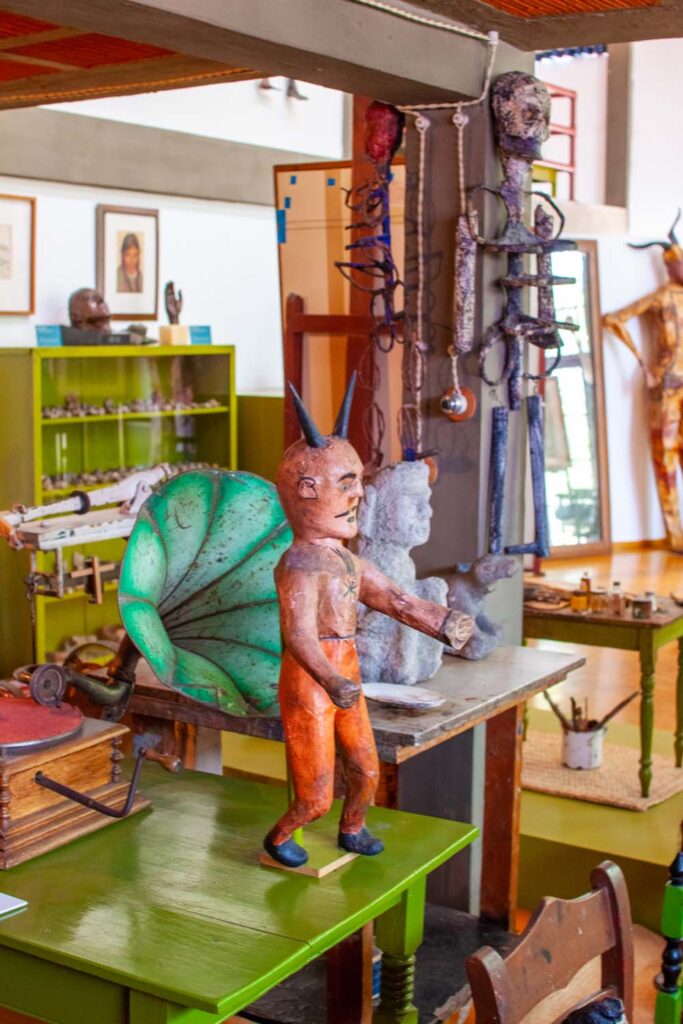
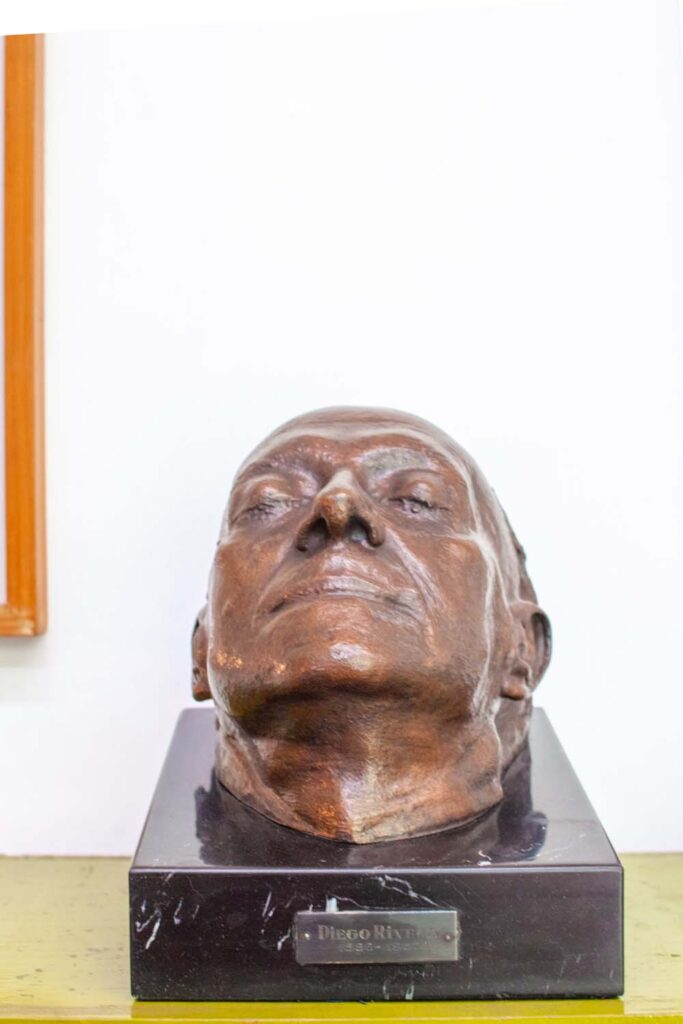
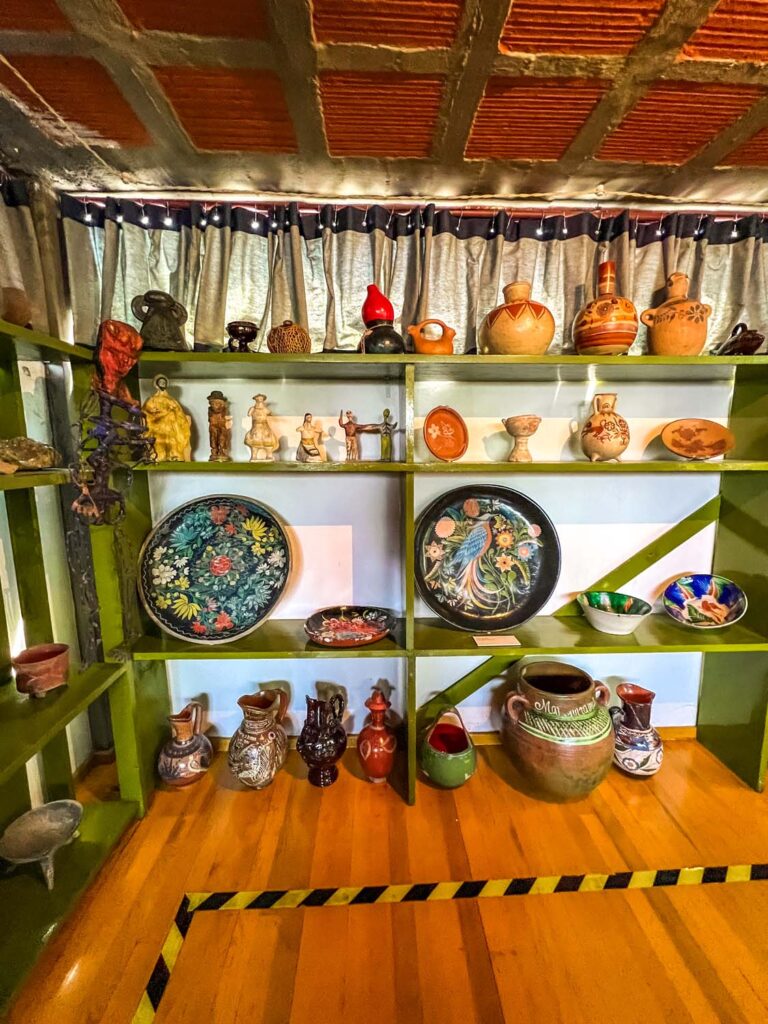
Plaza San Jacinto
Just a 5-minute drive from the museum/studio, make a stop in the Plaza San Jacinto. This beautiful park is a hub of activity on Saturday mornings. On the weekends, artisans of the San Angel neighbourhood descend on the park to display and sell their creations. Small groups of artists often sell throughout the week, but Saturdays are the most popular day. You’re guaranteed to find the marketplace bustling on those days.
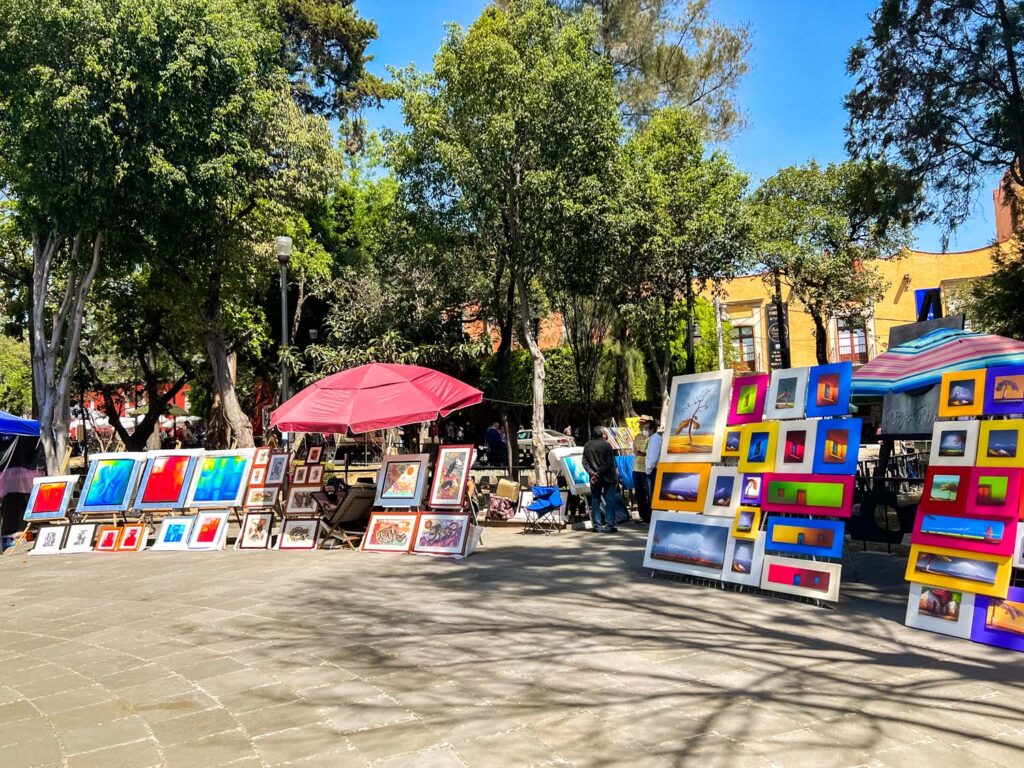
Make your way to the plaza’s centre and look across from the elegant central fountain. There, you will see a bronze easel with the burst of Diego Rivera emblazoned into the cartouche. As Rivera was a resident of the San Angel for many years, local artists inspired by Rivera wanted to commemorate him for generations to come. There is something wonderful about Rivera’s face looking over at the artists in the square selling their works. Continuing his passion for supporting Mexican artists, even from the great beyond.
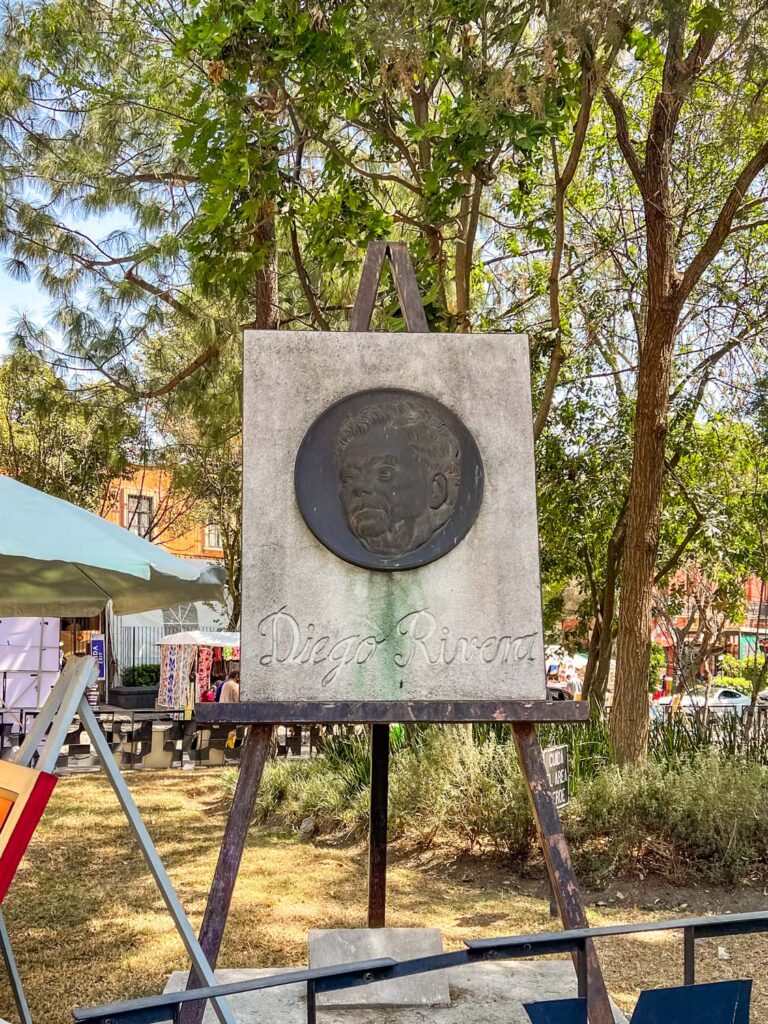
Casa de Cultura Jesús Reyes Heroles
Now let us head into the vibrant neighbourhood of Coyoacan. Our first stop is at the Casa de Cultura Jesús Reyes Heroles. This building is now a free cultural centre to enter and explore. The “House of Culture” was named in honour of the distinguished historian and political scientist Jesús Reyes Heroles. The building was originally located on an Izotitlán farm, a type of wild palm. Those palm trees still grow wild all over the property.
Just inside the entrance to the Casa is a sculpture of Frida and Diego sitting on a park bench, cast in bronze. You can sit alongside and get your picture taken with the famous couple. The house has existed here since 1780, occupied by various families. It’s no stretch to imagine that the previous owners would have welcomed the famous couple into their garden for a visit or a dinner party from time to time.
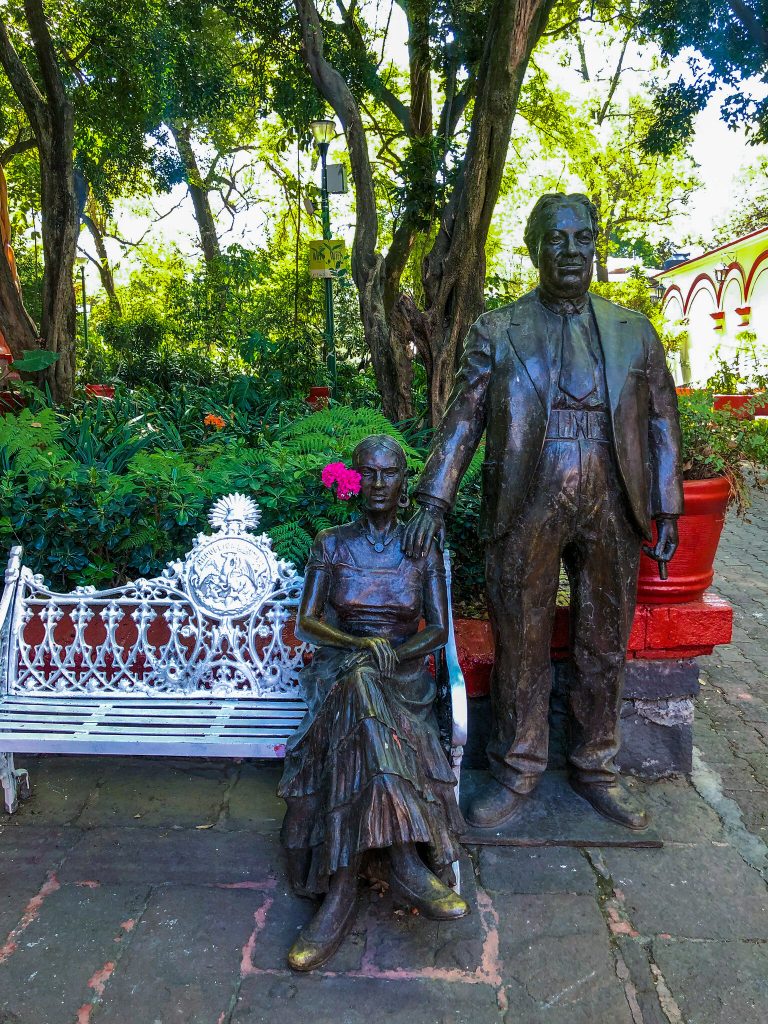
Casa Azul
La Casa Azul, or “the blue house,” located on Londres Street in Coyoacán, once belonged to Frida’s father, Guillermo Kahlo. It was here where she was born. She grew up inside these walls. It was where she suffered from illness but flourished as an artist. Eventually, Frida bought the house from her parents and lived with Diego throughout their marriage. They even got divorced and remarried, all within these blue walls. And ultimately, it was the place where she would pass away. It was her sanctuary but also her cage. She spent more years inside these walls than perhaps anywhere else in the world. As such, it is one of the most intimate looks into her life that you can experience.
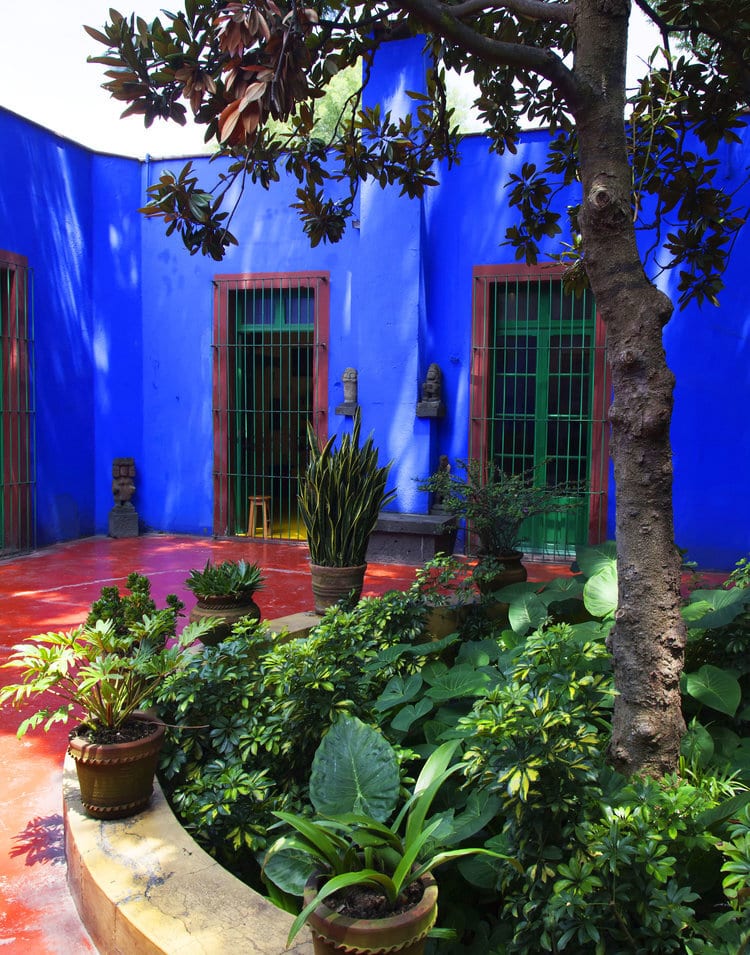
The museum is less of a simple art gallery and more like an inside look at Frida and Diego’s private world. The house has sketches by both artists and pictures of the two as a couple. But the main focus of the Casa Azul is the couple’s Mexican folk art. They collected pre-Hispanic artifacts, photographs, memorabilia, personal items, and more which are still on display. Walking inside their home, you feel a deep connection with Frida and Diego. To learn more about Casa Azul, take my self-guided tour!
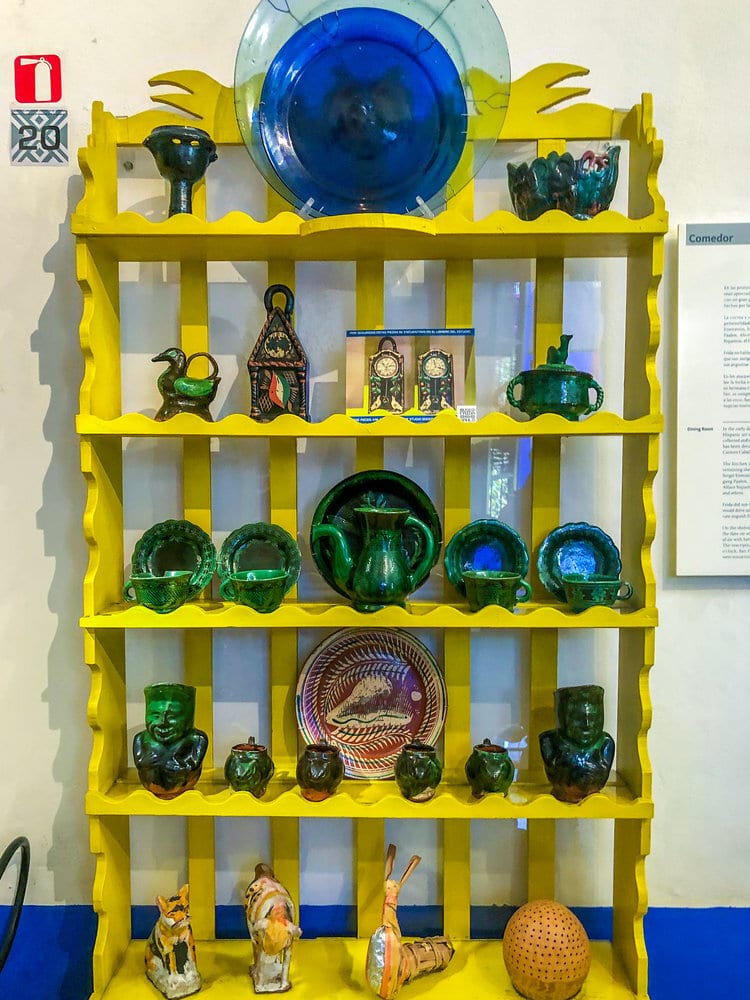
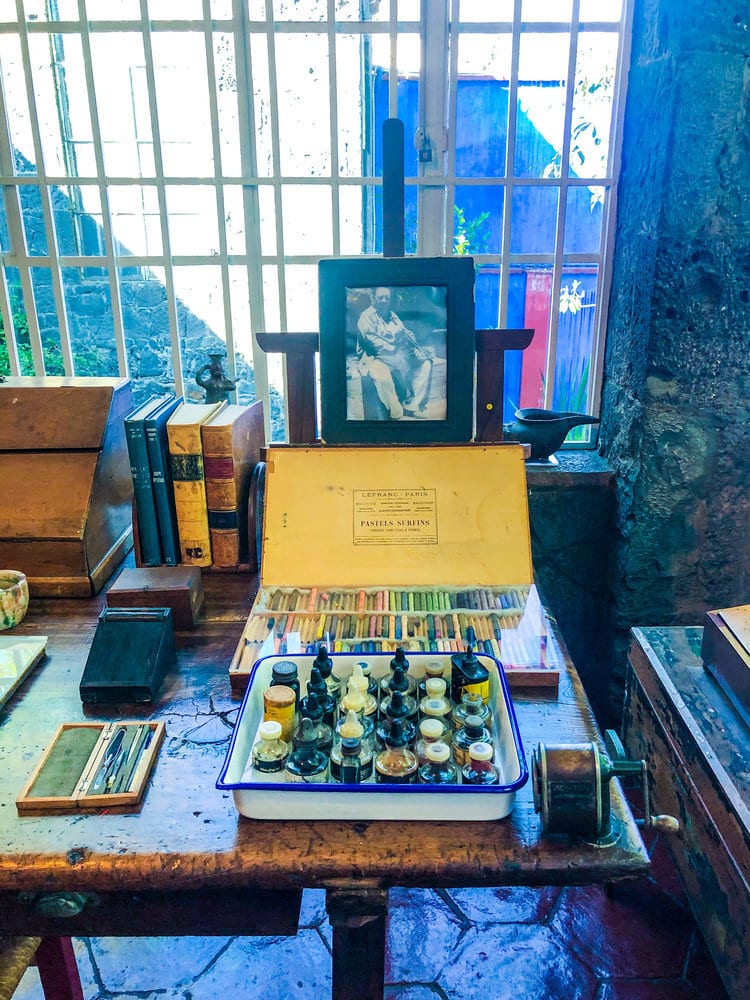
Frida Kahlo Park
Frida and Diego loved the outdoors. Diego often painted outside. The outdoors were an important part of their artistic life. In the centre of Coyoacan, you can make your way to Frida Kahlo Park. In the middle of the park, you’ll find two large bronze sculptures of Frida and Diego. Frida is dressed in her classic Tehuana outfit, gazing over at Diego. This park has a very structured layout, the bushes around it perfectly pruned into geometric shapes. Slightly resembling Aztec pyramids popping out in the background.
Museo Anahuacalli
If you are travelling to Xochimilco, you should stop by the Museo Anahuacalli. Your ticket into the Casa Azul also covers your entry into this museum. The Museo Anahuacalli was another one of Diego Rivera’s homes. Diego and Frida were fierce nationalists who loved their home country and wanted to preserve its history. Diego and Frida dreamed of opening their own museum dedicated to these objects. Sadly, in their lifetime, this dream never came to fruition. But after Diego’s death, his daughter took up the project and created the Museo Anahuacalli. Architect Juan O’Gorman, who designed their studio, also designed this house.
The house’s exterior was made using black volcanic stone from an old Mexico volcano. The texture is something truly unique. There are over 50,000 pre-Hispanic pieces inside the museum. Some of these Diego would collect while he and Frida would travel to ancient Aztec pyramids outside of Mexico City. Each one of them was a piece of Mexico’s heritage, a heritage that inspired the historical influences of Rivera’s artwork.
Museo Dolores Olmedo
Also, near Xochimilco, stop at the Museo Dolores Olmedo Museum. The museum is located inside the grounds of an old 16th-century residence. In 1962, Dolores Olmedo bought the house. Dolores was a fierce collector of art as well as a lover of Mexican culture. It is no surprise to learn then that she was old friends with Diego Rivera and Frida Kahlo. She was also one of their most prolific collectors, and her gallery remains the largest private collection of their works. In 1994, her collection was transformed into the museum we now find today. Luckily, Dolores lived until 2002, so she could see this fantastic house converted into an art gallery for the public to enjoy.
Olmedo & Rivera
Olmedo met Rivera when she was only 17 years old on a trip to Mexico City with her mother. They met while Rivera was working on his murals inside the Ministry of Education building. Inside the museum, you can see one of the portraits that Rivera painted of her. He made it in 1955 after their first meeting. As their friendship continued, Rivera continued to paint Olmedo and her children. They were so close, in fact, that Olmedo invited Rivera to spend time with her family in her home in Acapulco. Here, the painter made over 50 different paintings of sunsets from Olmedo’s front porch. Several of these paintings can be viewed inside the museum.
Today you can explore gardens filled with exotic Mexican plants, magical peacocks and Xoloitzcuintles. Xoloitzcuintles are a rare dog breed that was once only thought it exists in mythical stories of the afterlife. But the breed is actually an ancient hairless Aztec dog. The museum also features a permanent exhibition of works by Russian-Mexican artist Angelina Beloff, Diego Rivera’s first wife.
This brings us to the end of the Mexico City tour, walking in Diego Rivera’s footsteps. I hope you enjoyed your time with us and learned something new about the city along the way! Let me know in the comments what your favourite stop along the tour was!
Happy Travels, Adventurers!
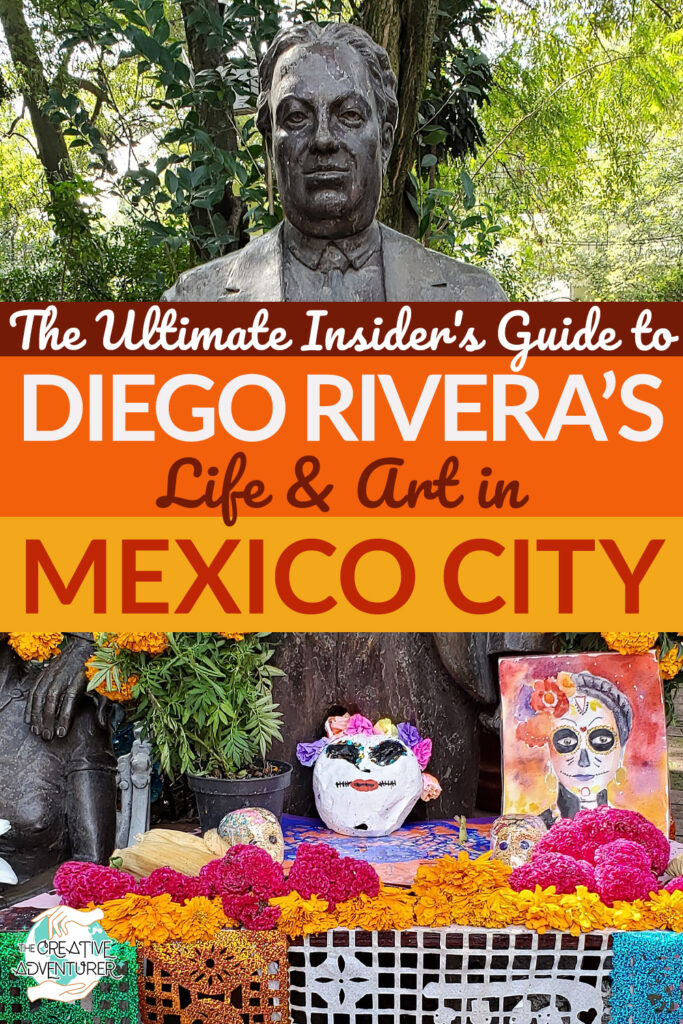
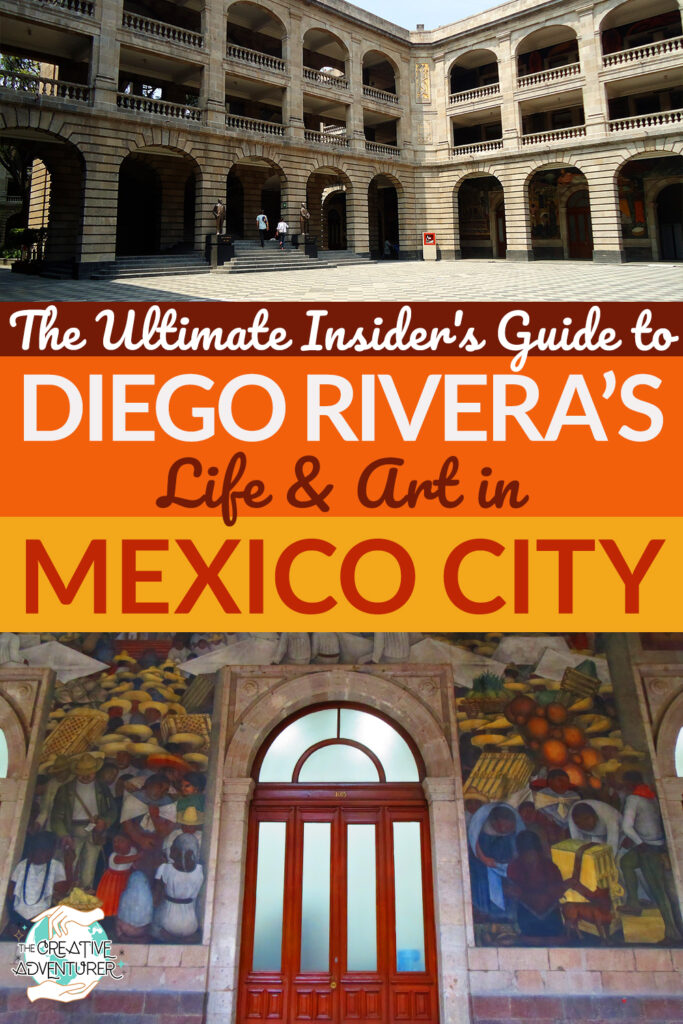
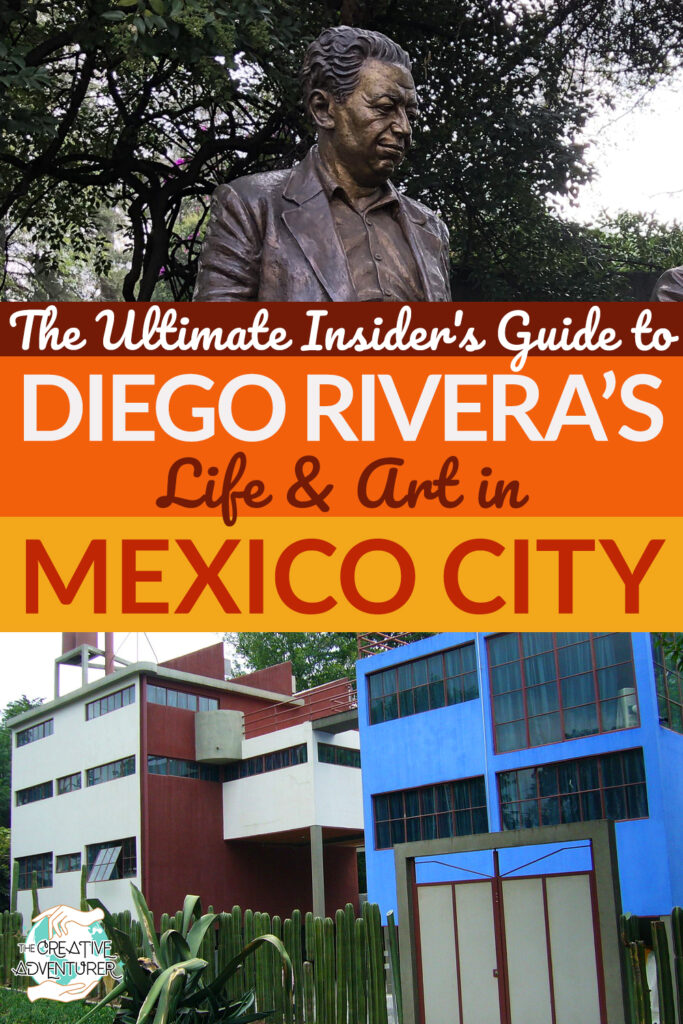
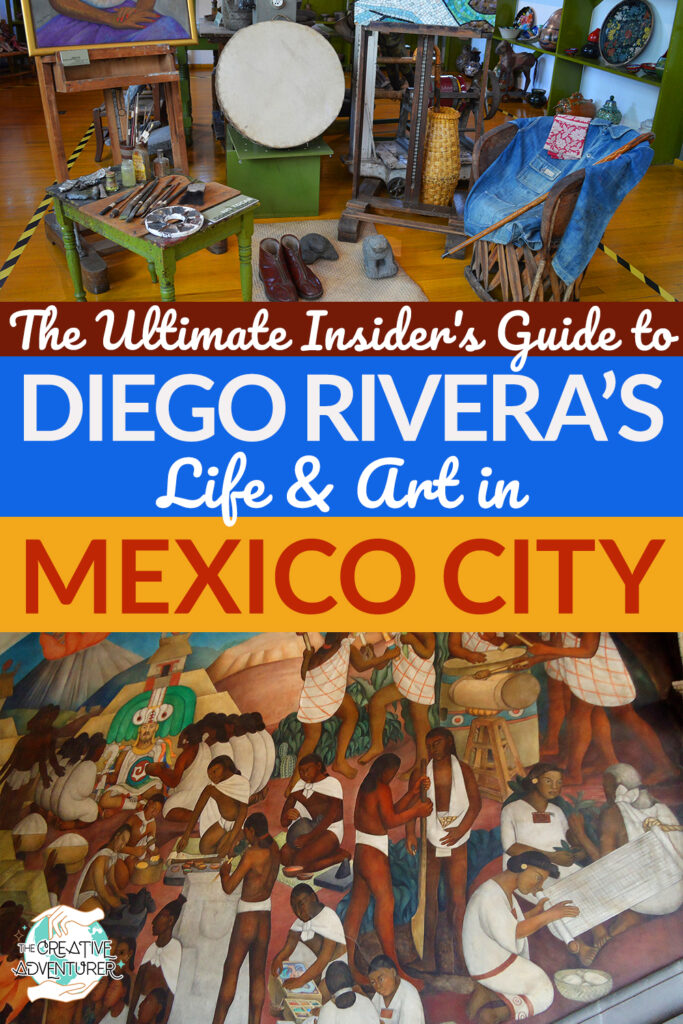
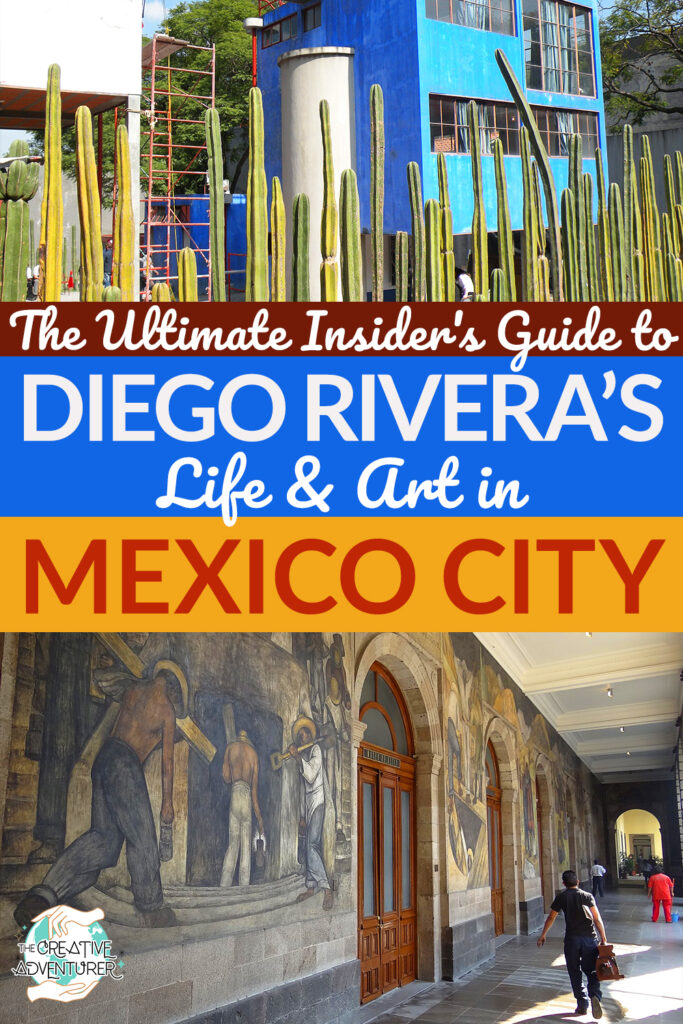
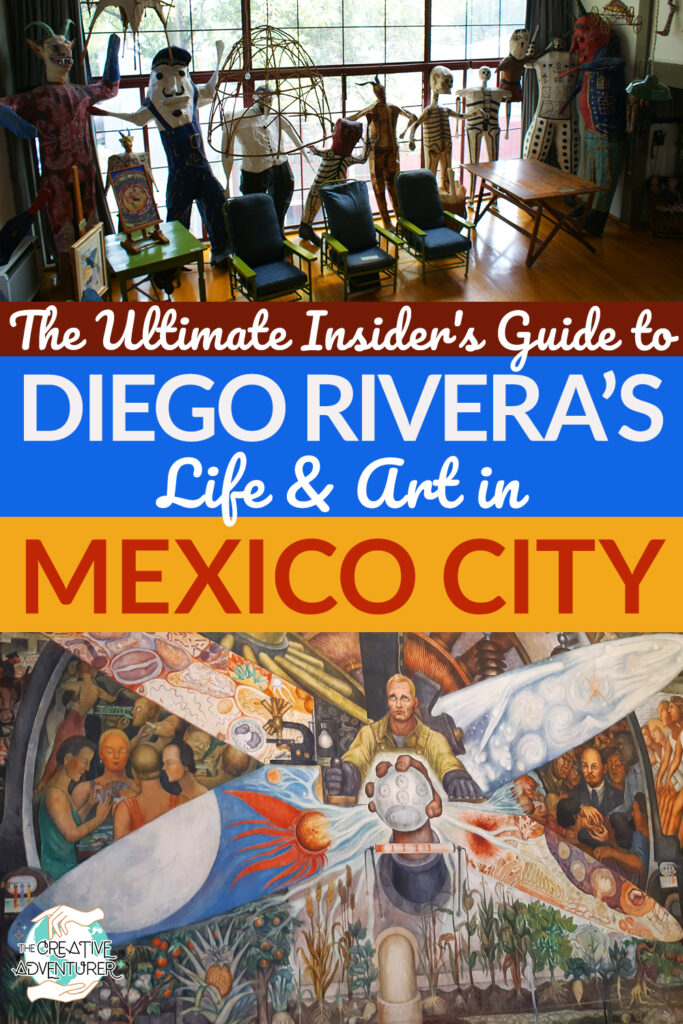


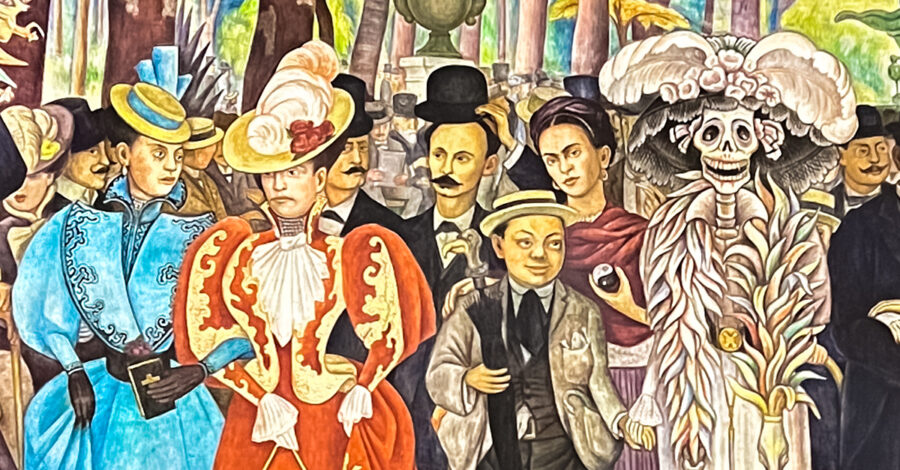
 ┇ 𝕄𝕚𝕘𝕦𝕖𝕝 𝔸𝕟𝕘𝕖𝕝 ┇
┇ 𝕄𝕚𝕘𝕦𝕖𝕝 𝔸𝕟𝕘𝕖𝕝 ┇
 (@theamazingcrack)
(@theamazingcrack) (@friducha.viajera)
(@friducha.viajera)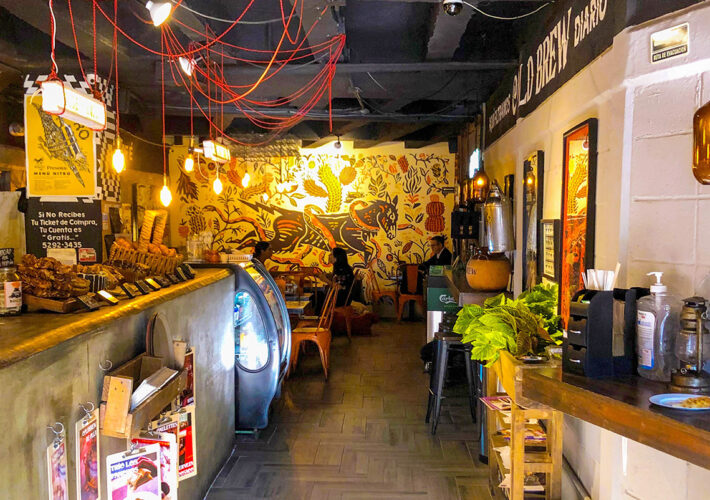
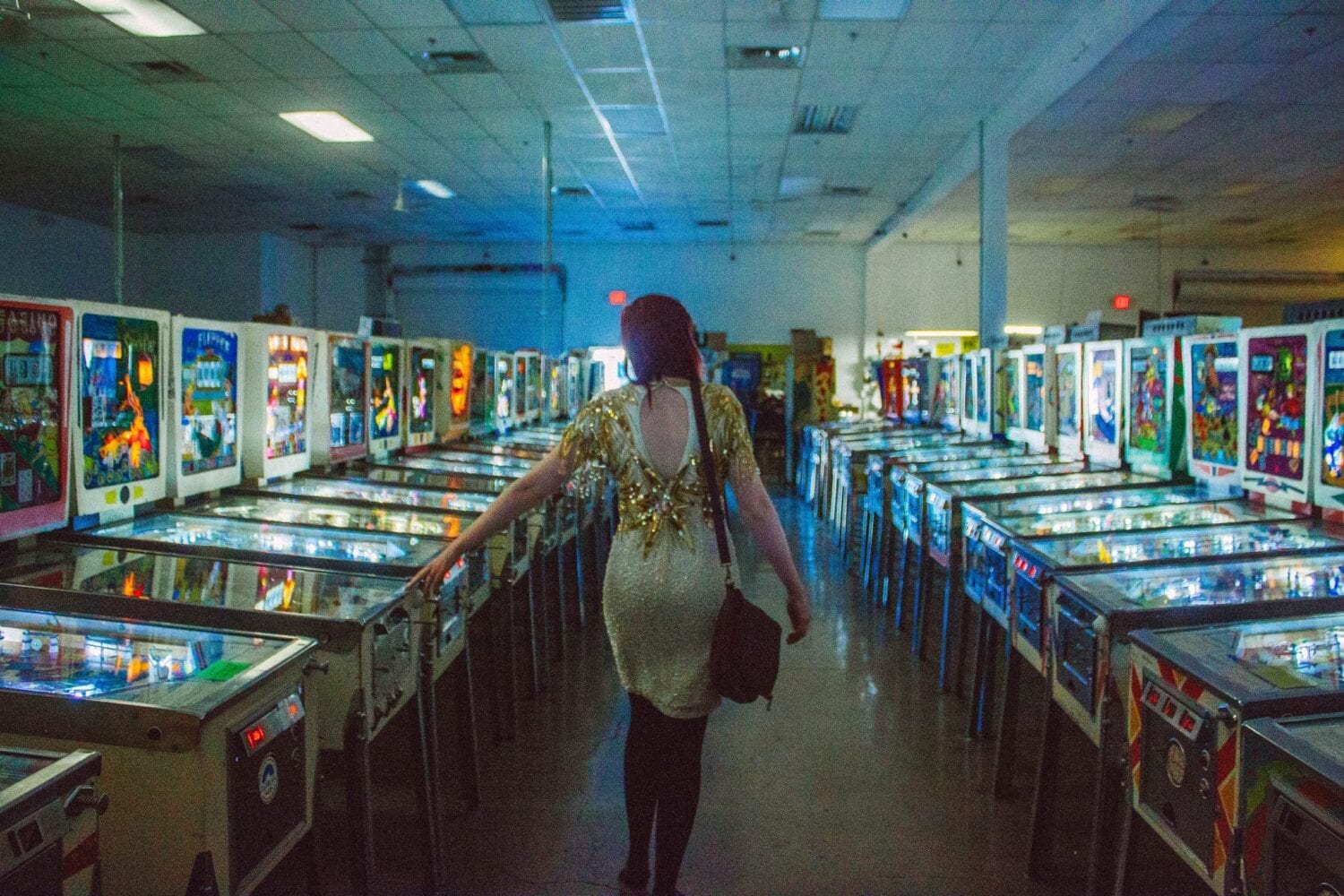

Leave a Comment